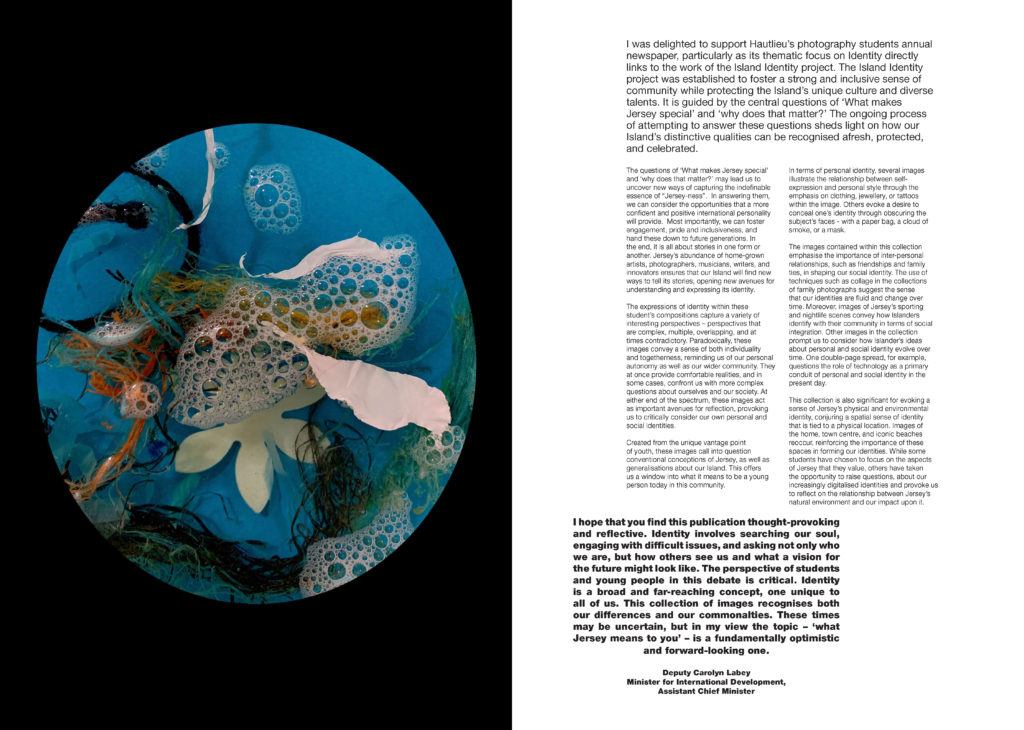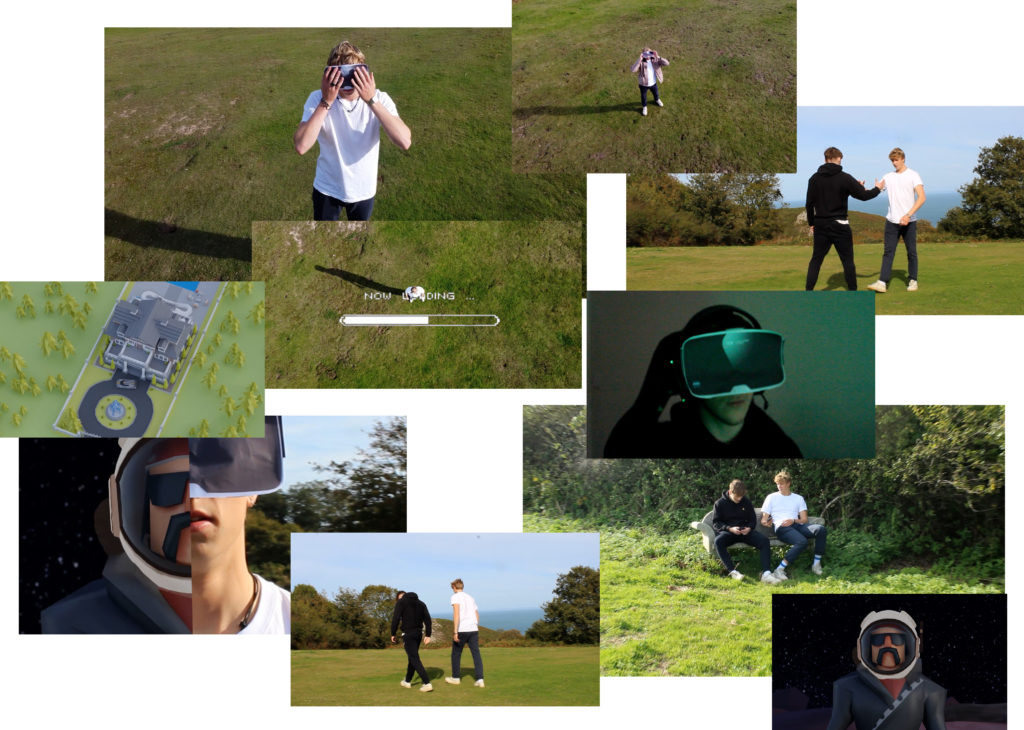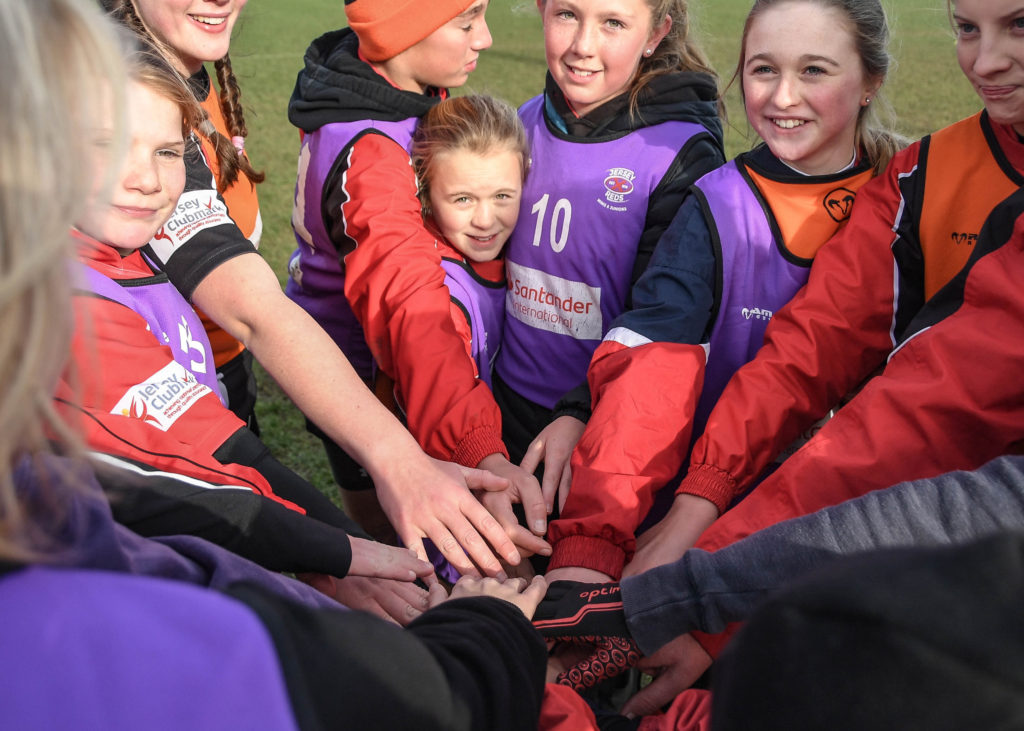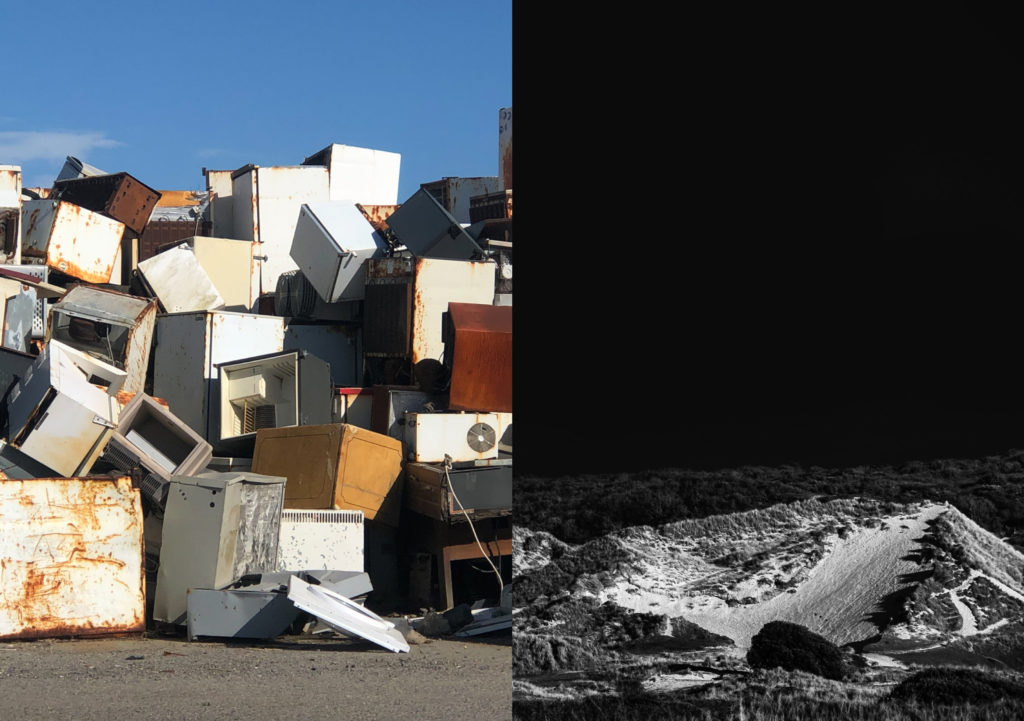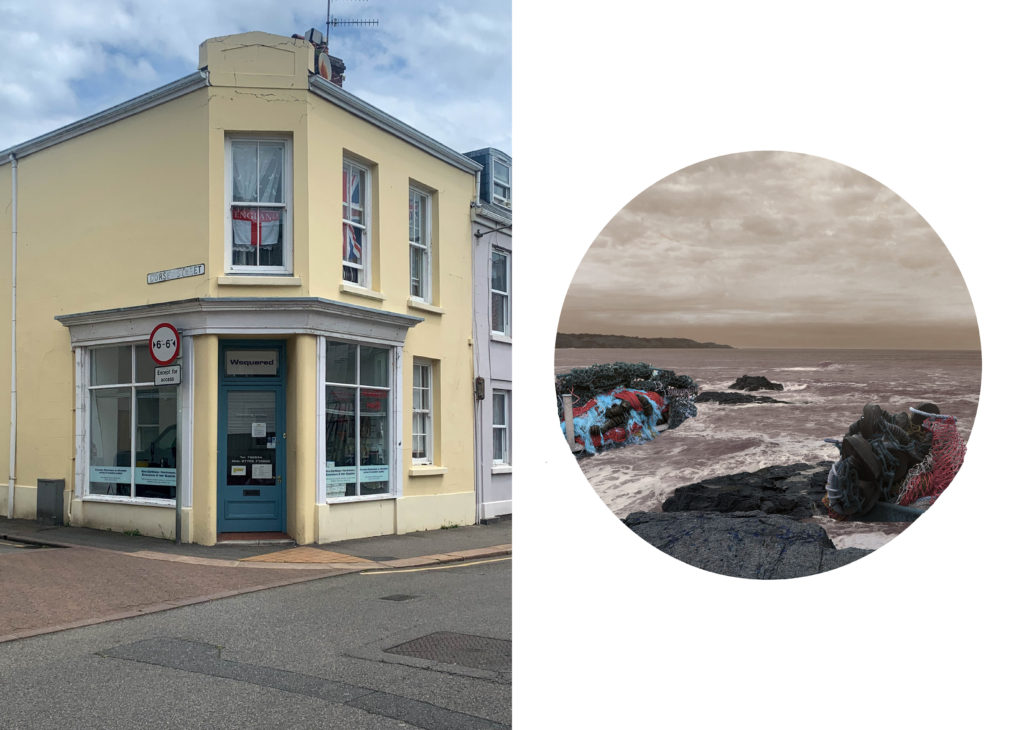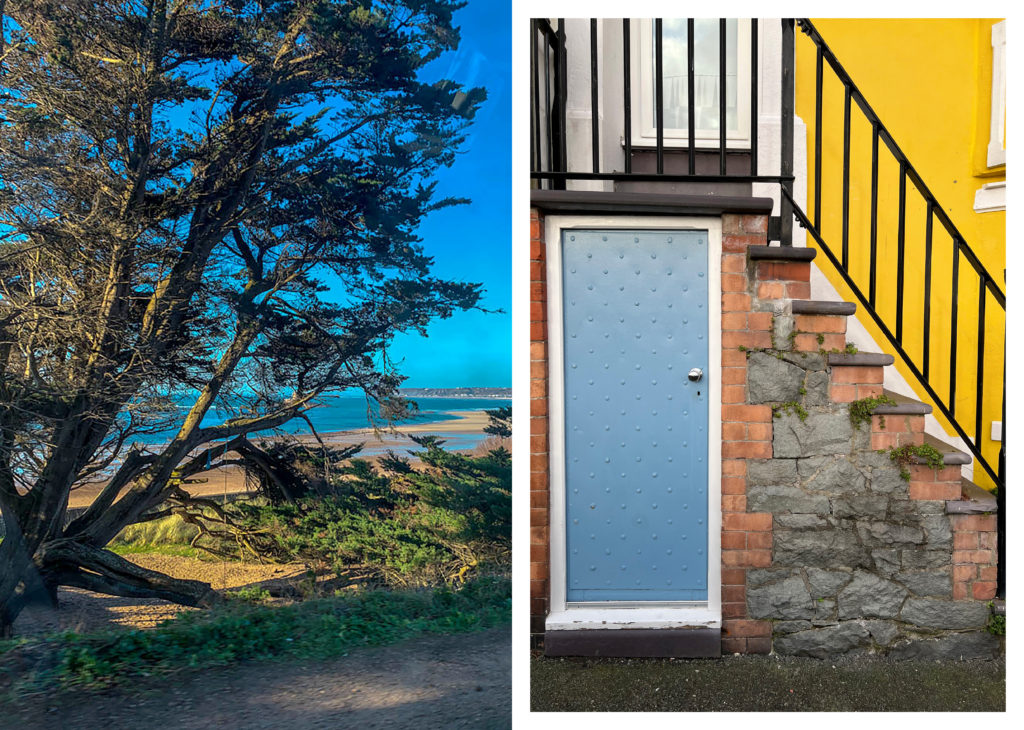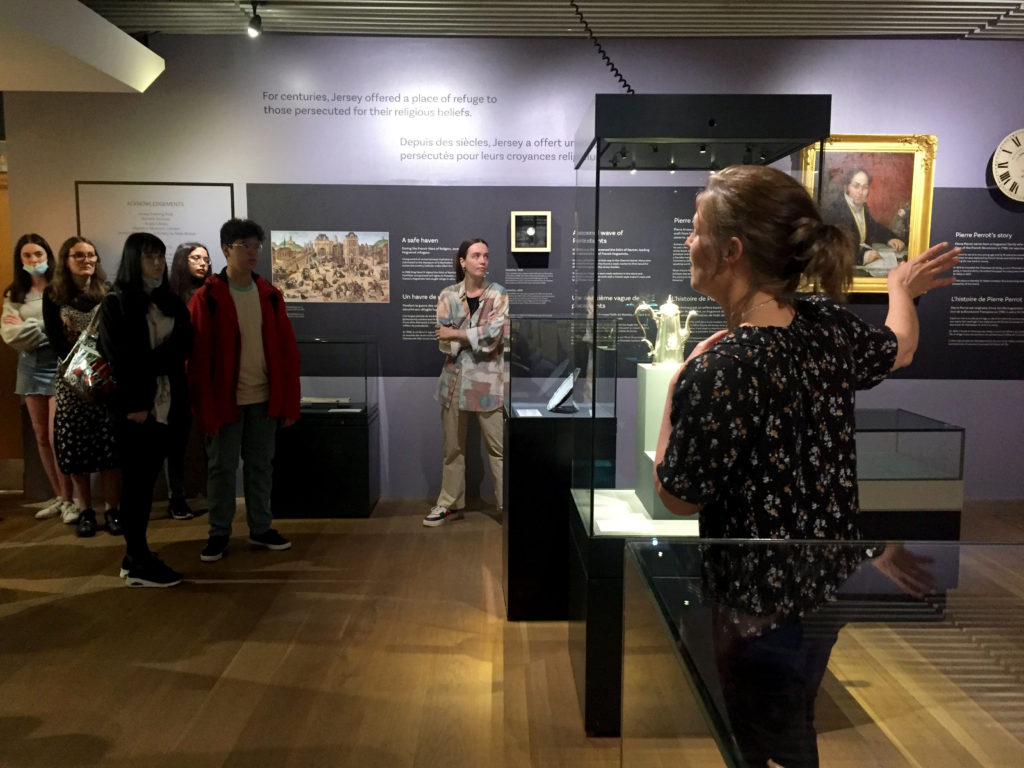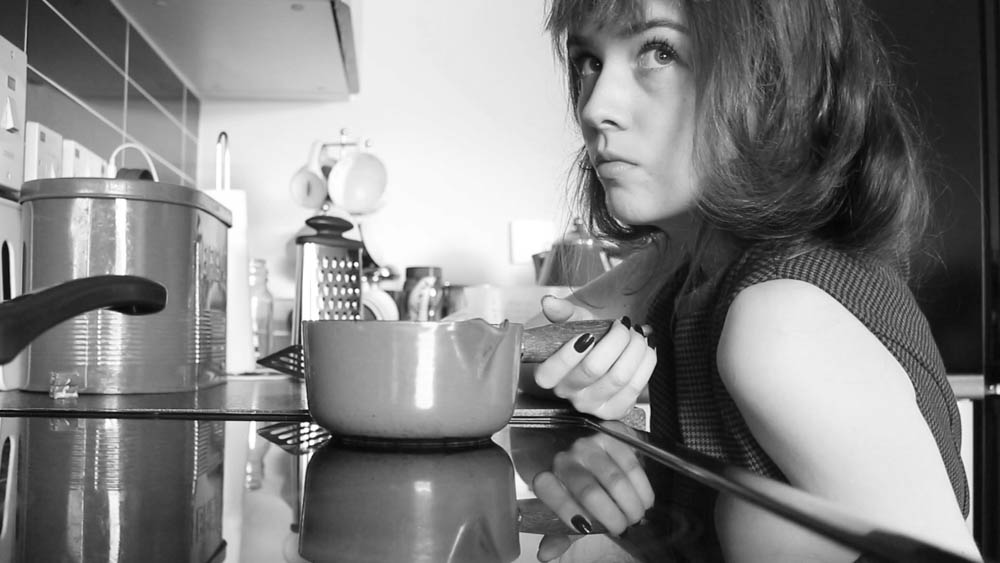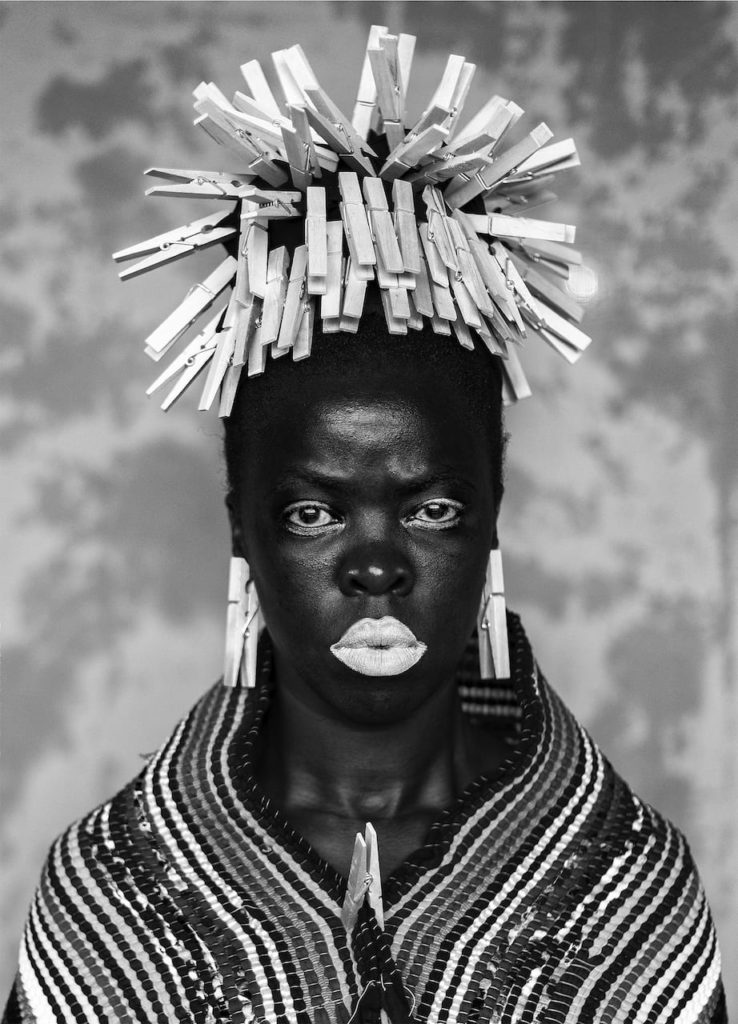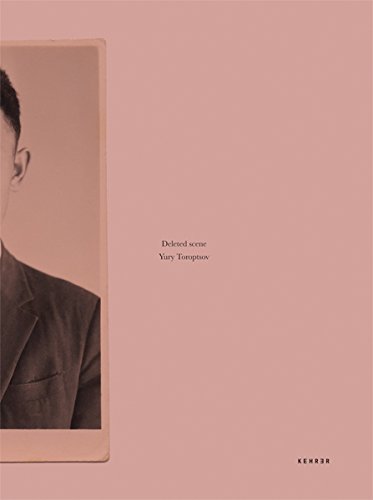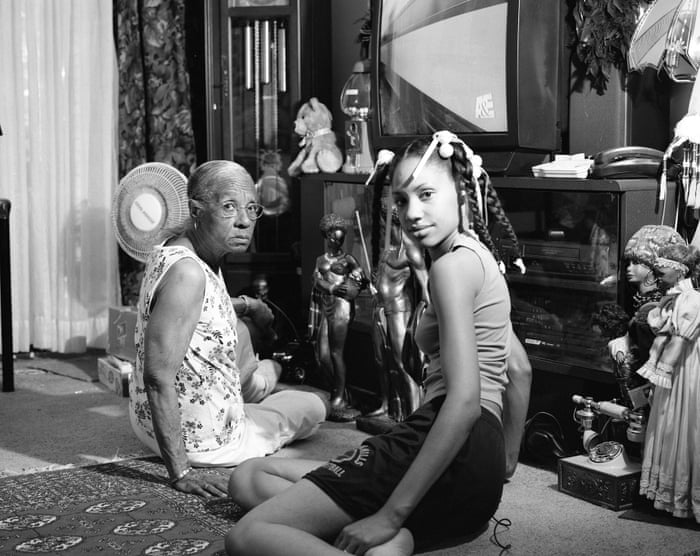Here is an online link to my photobook: The Hipsters
All posts by Mr Toft
Filters
final instructions + checklist
Here is a simplified check list of what we expect to see posted on the blog from each individual student for ALL COMPLETED WORK.
PHOTOBOOK
– Blog post showing how you developed your layout and comment on design process using screen grabs and annotation.
– Blog post with final layout with every spread and write an evaluation.
– Upload book design in Lightroom to Blurb and order your book via Blurb account
– Once you have received book in the post bring into school
LINK TO ONLINE BLURB BOOK
Your final blog post should be an online link to you BLURB book with an evaluation. If you have already written an evaluation as part of another blog post on your book design then add the online link to that blog post and change the date to make sure it sits at the top.

Log into your blurb account and click on Sell my book
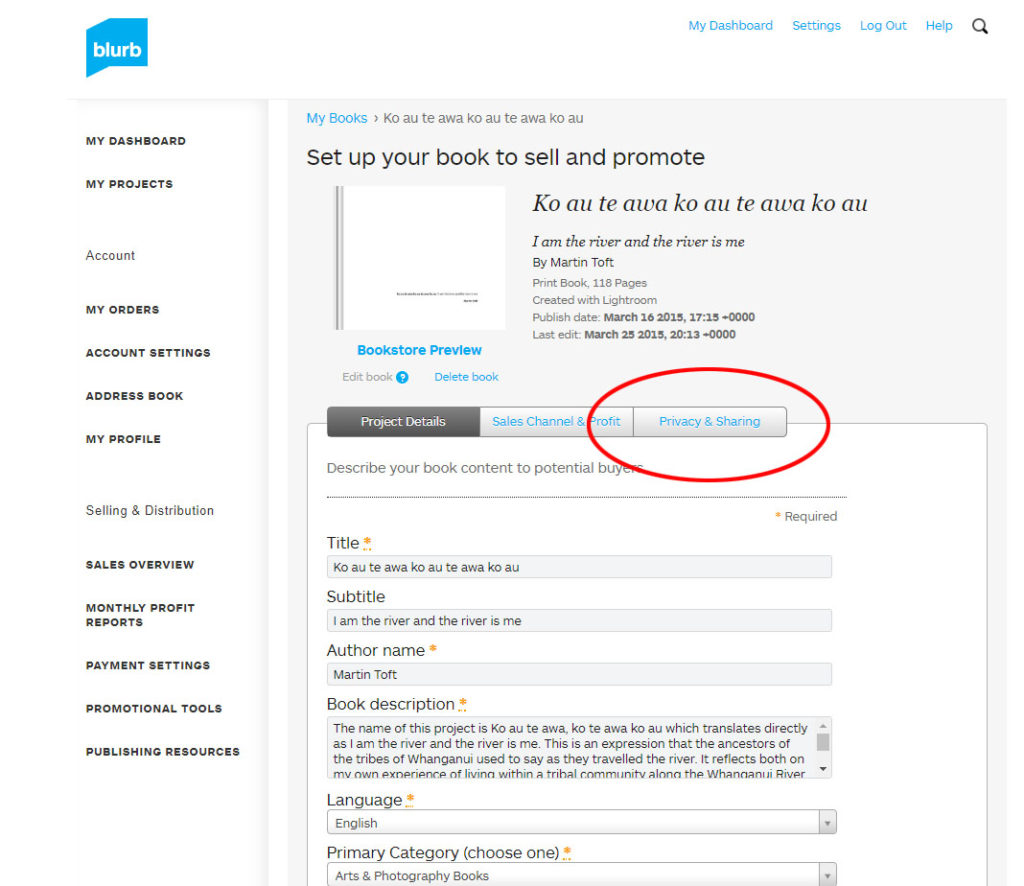
Click on Privacy & Sharing

Copy link circled in red above.

Make a new blog post: MY PHOTOBOOK and copy in link from Blurb into the title of your book using Link button above.
FILM
– Blog post showing how you edited your film and comment on editing process using screen grabs and annotation.
– Blog post with final film (streamed) and write an evaluation.
Export final film as mp4 file and upload to Youtube / Microsoft Streams and embed on Blog. Follow these steps
- In Premier: Click on Sequence > Render IN/OUT
- File > Export > Media
- Export Settings: Format H.264
- Output Name: use title of your film and save to V:Data drive
- Click Export at bottom
- Using Microsoft Stream: Open up Office 365
- Go to All Apps and select Stream
- Create > Upload Video
- Browse to upload your exported film from V:Data drive
- Write a short description, choose thumbnail and publish
- My Content > Videos > embed film into Blog post with evaluation.
- In Youtube: Set up an account at home (www.youtube.com)
- Click Create (top right corner) > Upload video
- Select file > your exported film from V:Data drive
- Write a short description and choose thumbnail
- Once uploaded, embed film into Blog post with evaluation.
- FINAL PRINTS
- – Mount and present final images. Make sure you put velcro and label on the back of the mounted image
- – Mock display: Blog post showing evidence of how you intend to present and display your final prints – make mock up in Photoshop – for example. a single image or diptych, triptych, predella, size A5, A4 or A3, typology-style grid, collage etc.
- – Virtual gallery: Download an empty gallery file…then insert your images and palce them on the walls. Adjust the persepctive, size and shape using CTRL T (free transform) You can also add things like a drop shadow to make the image look more realistic…

ALL COURSEWORK: Make sure all blog posts are completed – use Go4Schools tracking sheet.
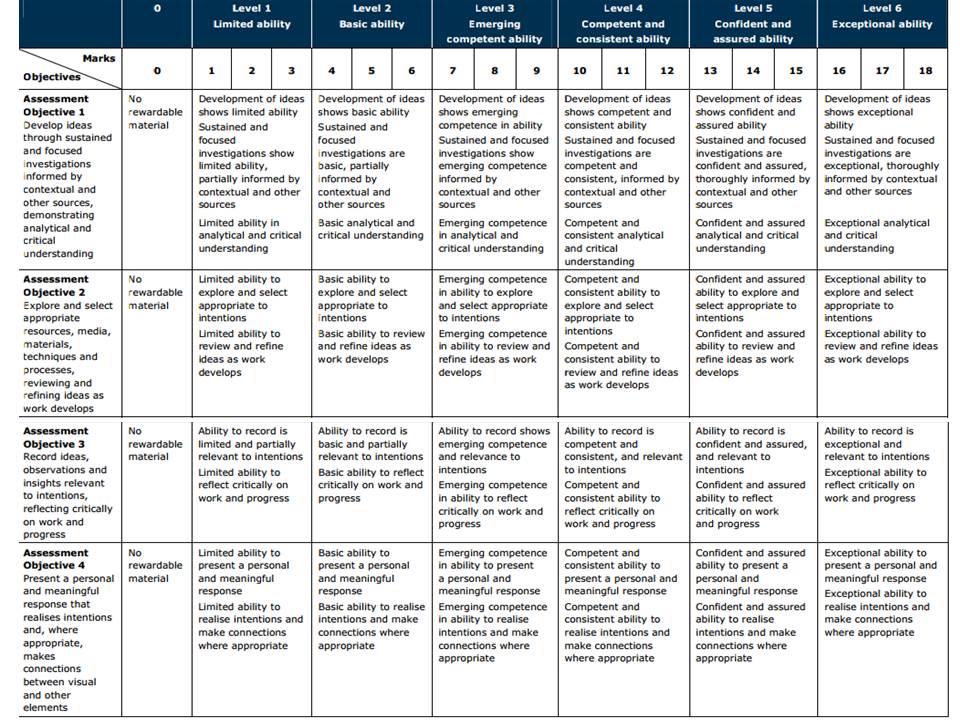
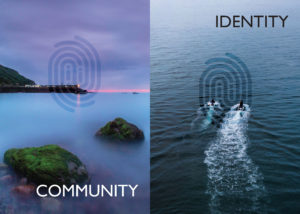
Identity & Community newspaper
Write an evaluation, reflecting on the experience of being part of making a newspaper and working on IDENTITY & COMMUNITY project and put it here at the top of the blog post, titled: IDENTITY & COMMUNITY. Specifically, select your images and spreads for comments.
Copy and past all the below and publish as your own blog post.
IDENTITY & COMMUNITY Newspaper
The images seen on the pages of this newspaper supplement are extracted from a variety of projects and final outcomes produced over a two-year academic programme of study by a group of A-Level photography students at Hautlieu School. In their final year the themes of Identity and Community offered a specific focus and through a series of creative challenges students developed a body of work that were inspired, partly from visiting heritage institutions to learn about aspects of Jersey’s unique history of immigration and exploring migrant communities and neighbourhoods in St Helier in a series of photo-walks. In the classroom additional inspiration was provided from workshops on NFTs (non-fungible token) and digital art, embroidery and textile art, animation and film-making, zine and photobook design led by professional artists, designers and teachers.
As part of the research and contextual studies students were asked to engage with some of the key questions raised by the Government of Jersey’s Island Identity project and explore through their own photographic studies how they interpret and identify distinctive qualities of island life. What can we learn from looking at a set of photographs produced by young islanders? At first sight they show us a seemingly random set of images of places, people and objects – some familiar, others surprising. On closer inspection each image is a visual sign and also a conundrum. For example, a fish stuffed in a plastic bottle may ask us to consider more closely our marine environment, commercial fishing or food consumption. As a combined sequence of images they represent different views that in many ways comment on a wider discussion on some of the primary objectives explored in the Island Identity project, such as ‘how we see ourselves’ and ‘how others see us.’
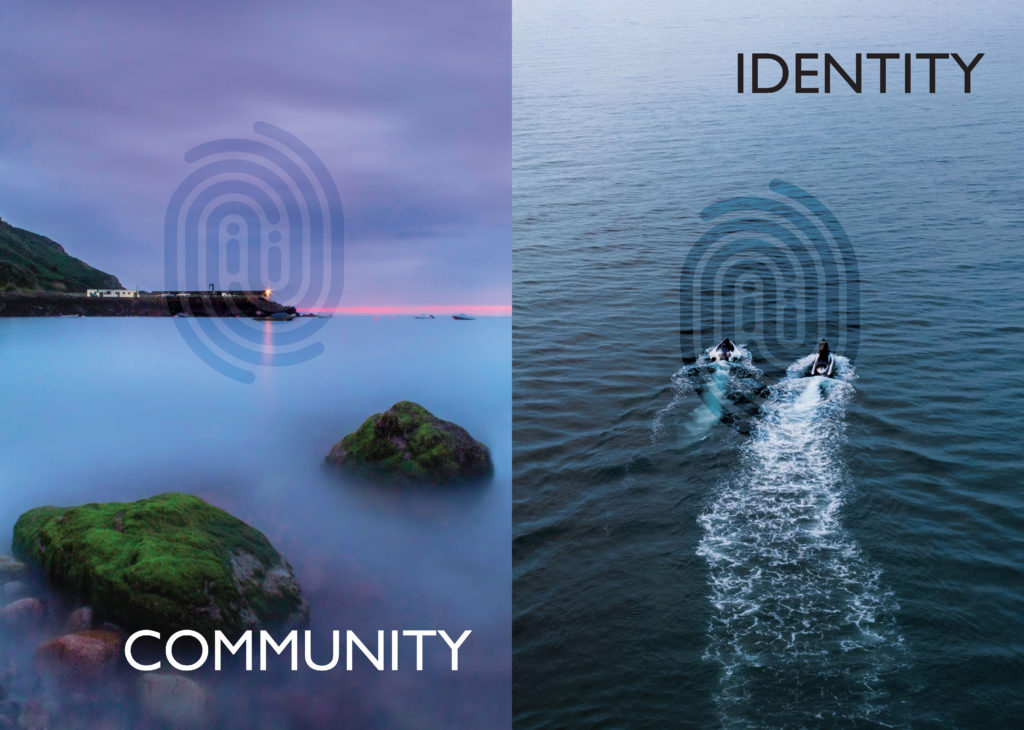
The newspaper was kindly sponsored by Deputy Carolyn Labey, Minister for International Development and Assistant Chief Minister who in her foreword shares her personal thoughts on what makes Jersey special to her in context of the Island Identity project led by her department. She says, ‘identity involves searching our soul, engaging with difficult issues, and asking not only who we are, but how others see us and what a vision for the future might look like. The perspective of students and young people in this debate is critical. Identity is a broad and far-reaching concept, one unique to all of us. This collection of images recognises both our differences and our commonalties. These times may be uncertain, but in my view the topic – ‘what Jersey means to you’ – is a fundamentally optimistic and forward-looking one.’
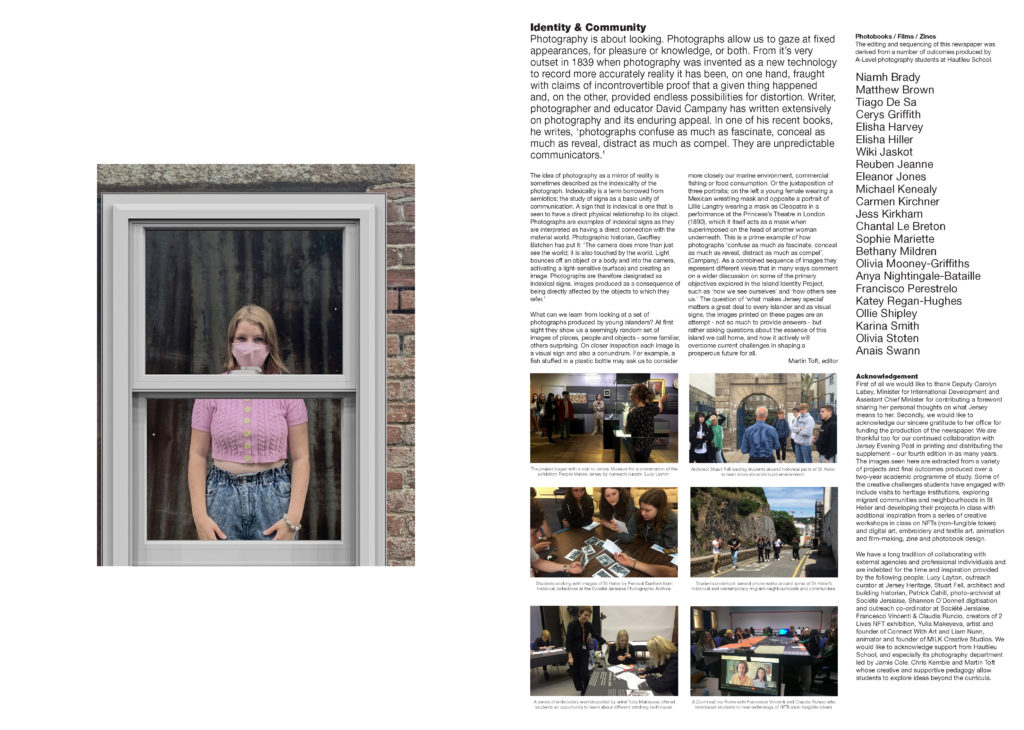
The Identity and Community newspaper is the fourth supplement produced in collaboration between Hautlieu School Photography Department and Jersey Evening Post. In 2018 the first issue was The Future of St Helier and last year the themes of Love & Rebellion explored experiences of isolation and lockdown during the coronavirus pandemic. Photographer and teacher Martin Toft, comments: ‘The question of ‘what makes Jersey special’ matters a great deal to every islander and as visual signs, the images printed on these pages are an attempt – not so much to provide answers – but rather asking questions about the essence of this island we call home, and how it actively will overcome current challenges in shaping a prosperous future for all.’

Exam Guidance
Mon 4 – Wed 6 April: Class 13B
Wed 6 – Fri 8 April: Class 13C
DEADLINE: LAST DAY OF YOUR EXAM
PHOTOBOOKS / FILM > FINAL PRINTS > PORTFOLIO > BLOG POSTS
IN PREPARATION FOR EXAM MAKE SURE THE FOLLOWING IS READY IN ADVANCE OF YOUR FIRST DAY:
- Upload new photoshoots and edit in Lightroom – make sure to produce blog posts showing selection process and experimentation of images.
- A draft layout of your photobook/ rough cut of film edit before your Mock Exam begin (that time is used to fine tune design with teacher)
- Review your PORTFOLIO folder and make sure you have a good selection of final outcomes incl: previous Yr 12 projects, zine, NFT film + image, final prints and final essay (published on the blog as a separate post). If there are any gaps, or if you wish to re-do window mounts/ foamboard – make sure you save high-res images in PRINT FOLDER – EXAM
- Make sure you monitor and track your progress by Fri 1 Dec and complete blog posts from previous tasks.
Structure your 3 day Exam as follows:
DAY 1:
Photoshoots/ recordings: Complete final editing images or recordings for your photobook / film + produce blog posts showing selection process and experimentation of images. Use a combination of print screens + annotation. Write an evaluation about what went well and compare/ contrast with artists references and inspirations.
DAY 2
Photobook/ film: Complete photobook design/ edit film + produce blogpost showing a clear design process and evaluate. Use a combination of print screens + annotation. Compare and contrast with photobook artist/ inspiration.
DAY 3
Prints: Select 5-7 prints and consider presentation producing mock up in Photoshop and/or create virtual gallery. Make sure to produce a good blog post evidencing the above.
PORTFOLIO: Review your folder and make sure you have a good selection of final outcomes incl: zine, NFT film + image, final prints, essay (published as a separate blog post) and photobook/ film. If there are any gaps, or if you wish to re-do window mounts/ foamboard – make sure you save high-res images in PRINT FOLDER MOCK EXAM.
PHOTOBOOK
Make sure you have a made a blog post that charts your design decisions, including prints screens of layout with annotation and write an ongoing evaluation. If you complete it; final book design must be checked and signed off by teacher.
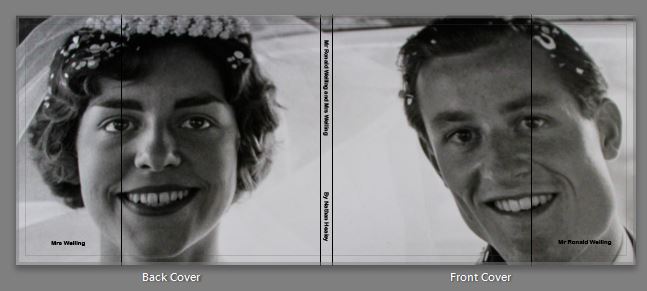




For more help and guidance editing, process and evaluation go to blog post below.
BLURB – ORDER BOOK
Inside Lightroom upload book design to BLURB, log onto your account on their website, pay and order the book.
Consider spending a few extra pounds on choosing better paper, such as Premium Lustre in check-out, change colour on end paper or choose different cloth/ linen if needed.
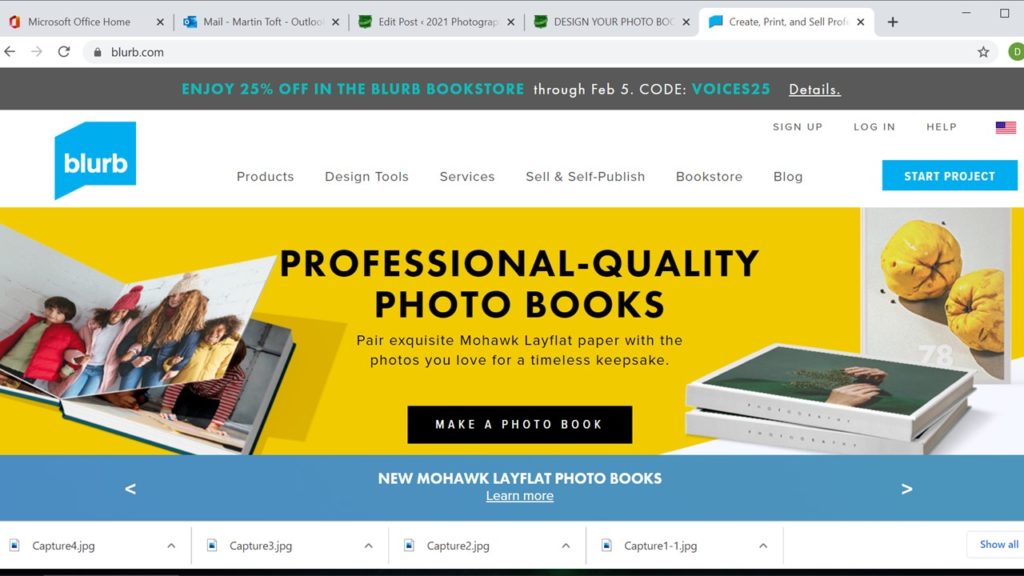
FILM
Make sure you have a made a blog post that charts your editing process, including prints screens with annotation and write an evaluation. If you complete it; final film must be checked and signed off by teacher.
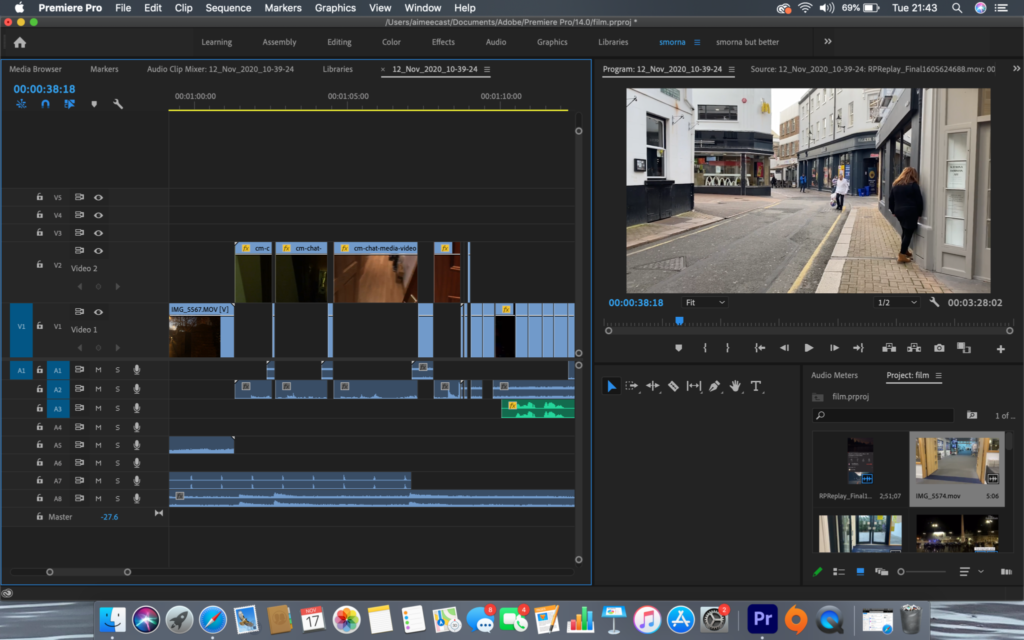
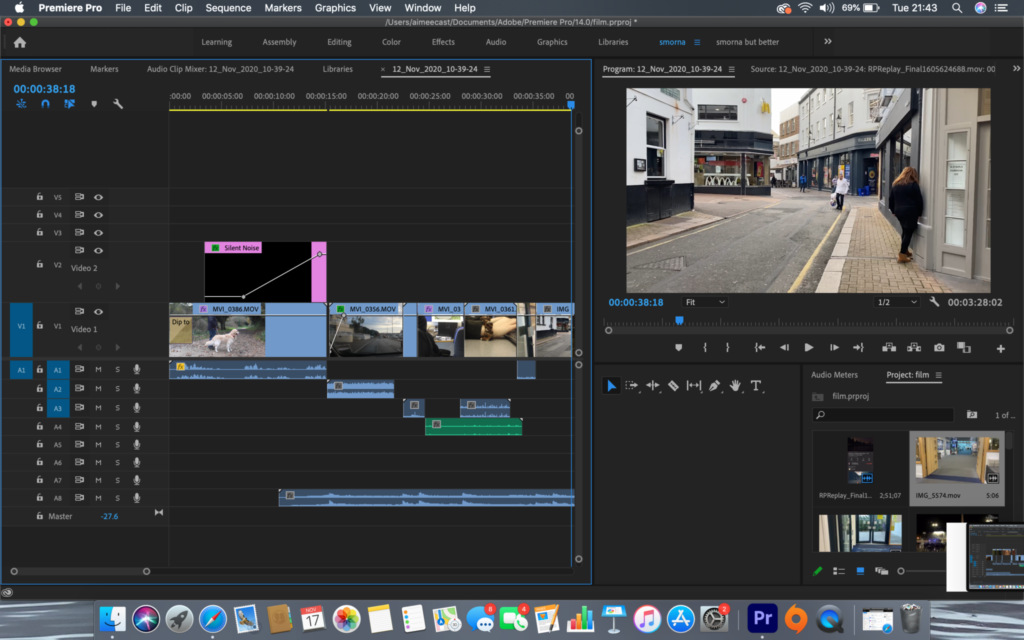
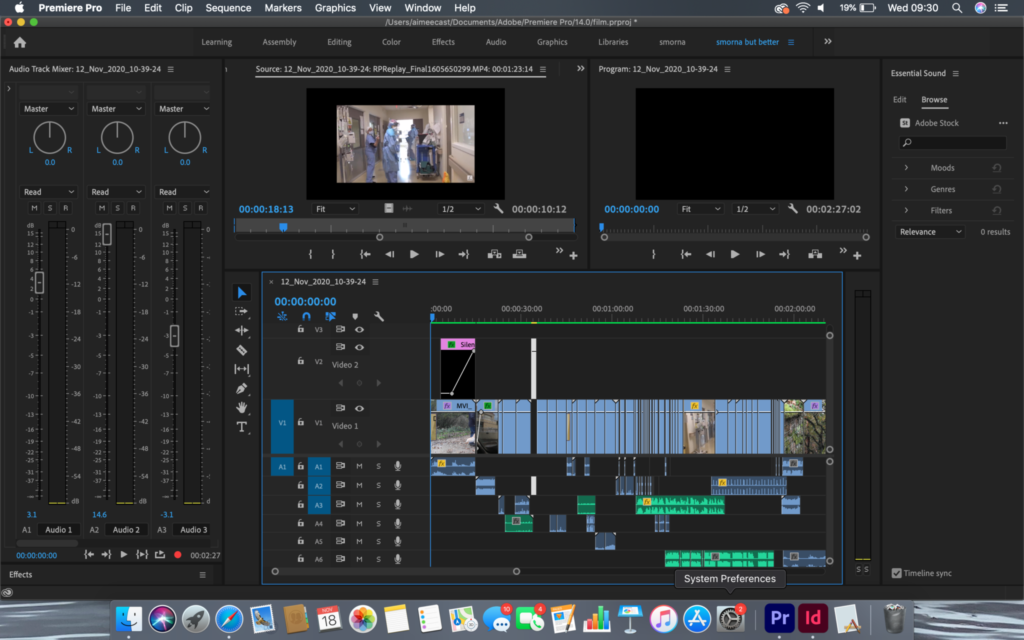
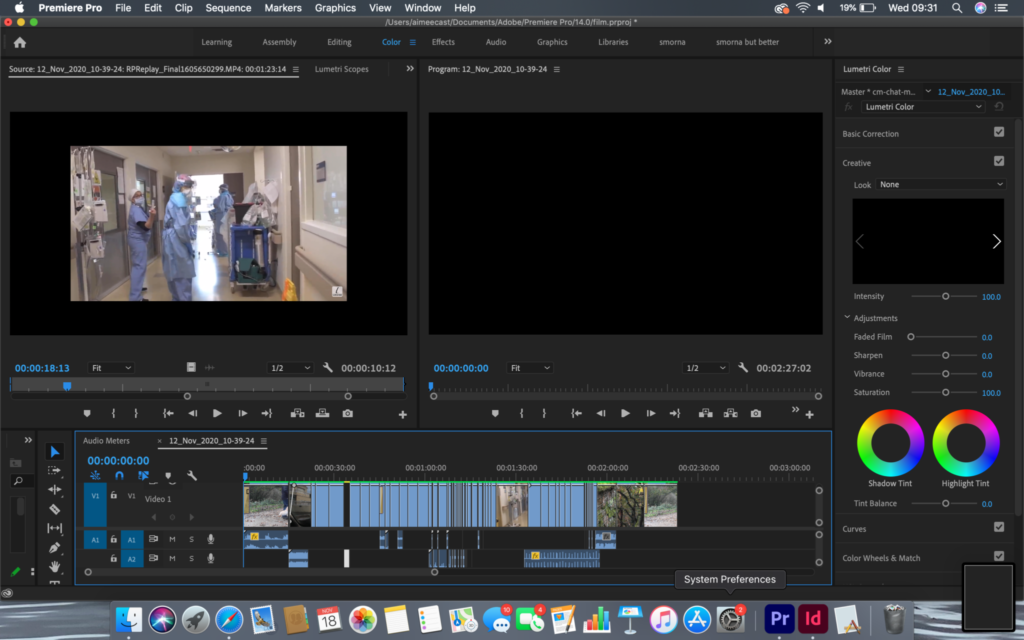
For more help and guidance on editing, process and evaluation go to blog post below.
Export final film as mp4 file and upload to Youtube / Microsoft Streams and embed on Blog. Follow these steps:
- In Premier: Click on Sequence > Render IN/OUT
- File > Export > Media
- Export Settings: Format H.264
- Output Name: use title of your film and save to V:Data drive
- Click Export at bottom
- Using Microsoft Stream: Open up Office 365
- Go to All Apps and select Stream
- Create > Upload Video
- Browse to upload your exported film from V:Data drive
- Write a short description, choose thumbnail and publish
- My Content > Videos > embed film into Blog post with evaluation.
- In Youtube: Set up an account at home (www.youtube.com)
- Click Create (top right corner) > Upload video
- Select file > your exported film from V:Data drive
- Write a short description and choose thumbnail
- Once uploaded, embed film into Blog post with evaluation.
BLOGPOSTS
All blog posts in relation to the above must be published, including any other posts missing from previous work modules since the beginning of A2 academic year, including Zines which must be printed & bound, and NFT film and digital image, including a statement, uploaded to both blog and folders here ready for the exhibition:
M:\Departments\Photography\Students\Image Transfer\IDENTITY & COMMUNITY\NFT
See previous student, Stanley Lucas as a guide on blogposts that needs to be done and published before you the end of your Mock Exam
FINAL PRINTS
Select your final prints (5-7) from photobook/ film and make a blog post showing ideas about how to present them.
In photoshop produce a mock display (create new document size A1: 594 x 841mm) using different image sizes, for example: A3 x 2, A4 x 2, A5 x 3
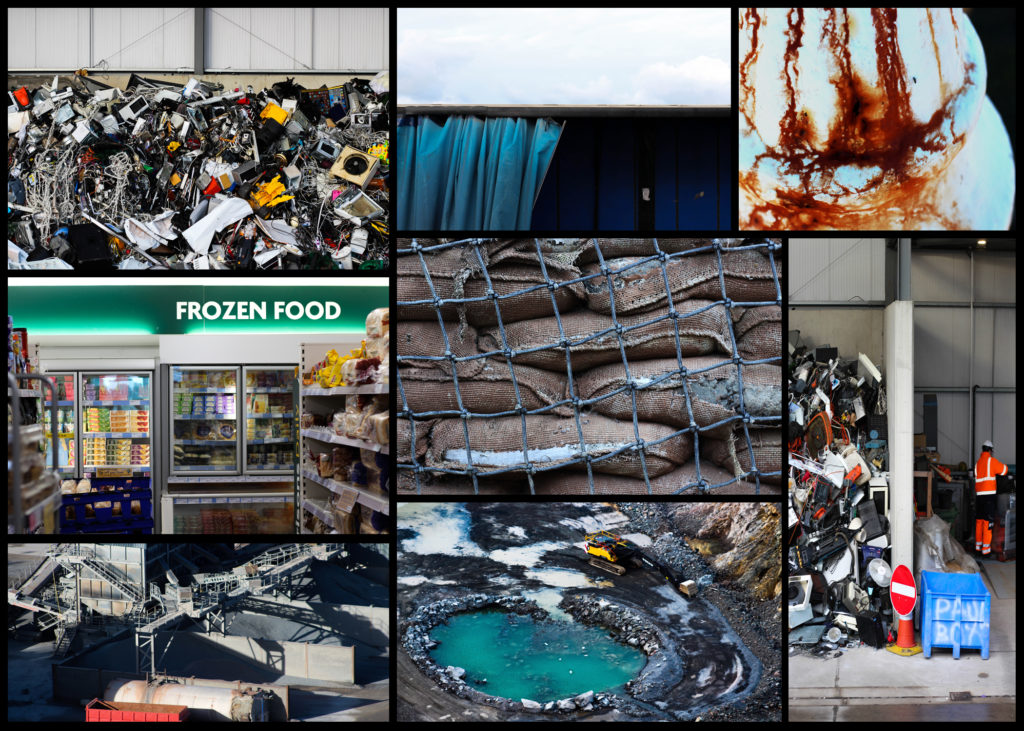
PREPARE AND SAVE IMAGES FOR PRINTING:
- Add your images to the print folder here…M:\Radio\Departments\Photography\Students\Image Transfer\PRINTING YR 13 MOCK EXAM
- Complete any unfinished work from last term if you have time, For example: select images for print form Zine and NFT projects.
File Handling and printing...
- Remember when EXPORTING from Lightroom you must adjust the file size to 1000 pixels on the Short edge for “blog-friendly” images (JPEGS)
- BUT…for editing and printing when EXPORTING from Lightroom you must adjust the file size to Short edge for “high resolution” images (JPEGS) like this…

- A5 Short Edge = 14.8 cm
- A4 Short Edge = 21.0 cm
- A3 Short Edge =29.7 cm
This will ensure you have the correct ASPECT RATIO
Ensure you label and save your file in you M :Drive and then copy across to the PRINT FOLDER / IMAGE TRANSFER
For a combination of images, or square format images you use the ADOBE PHOTOSHOP > NEW DOCUMENT + PRINT PRESETS on to help arrange images on the correct size page (A3, A4, A5)
You can do this using Photoshop, Set up the page sizes as templates and import images into each template, then you can see for themselves how well they fit… but remember to add an extra 6mm for bleed (3mm on each side of the page) to the original templates. i.e. A4 = 297mm x 210 but the template size for this would be 303mm x 216mm.
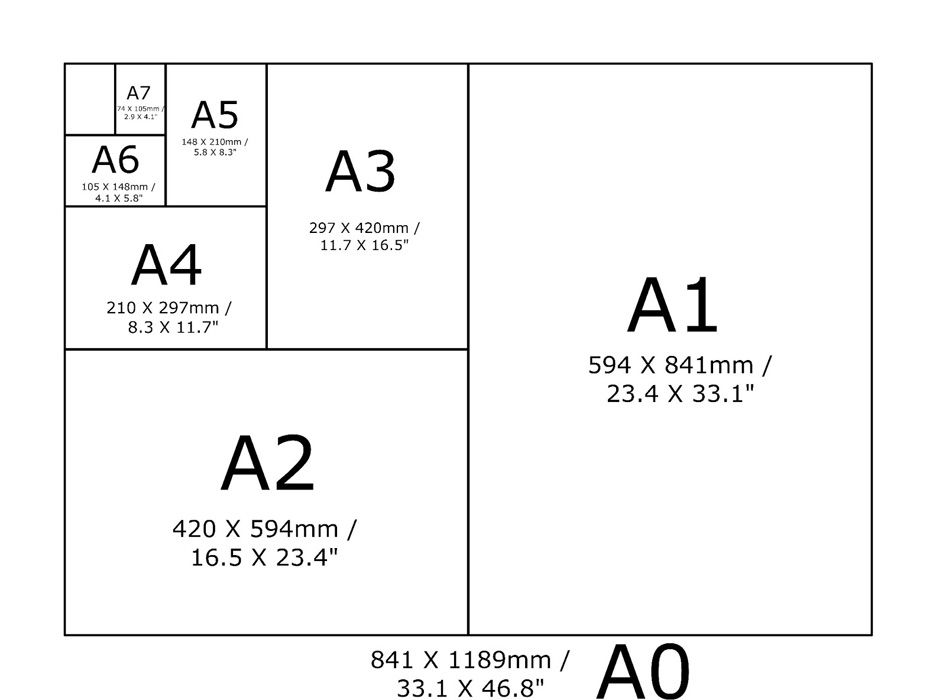
Making a Virtual Gallery in Photoshop
Download an empty gallery file…then insert your images and palce them on the walls. Adjust the persepctive, size and shape using CTRL T (free transform) You can also add things like a drop shadow to make the image look more realistic…
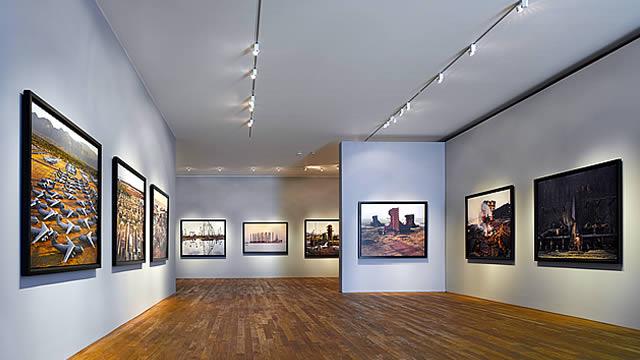

…or using online software
How I did it:
Step 1: Go to www.artsteps.com
Step 2: Sign in / up.
Step 3: Create.
Step 4: Create your own location or choose a template.
Step 5: Upload your images, put them in your exhibition, name it and give it a description.
Step 6: Present / view your Exhibition.

Newspaper
Historically, photography students at Hautlieu School have acquired a reputation for making work beyond the confines of Edexcel syllabus and their work have been recognised both locally and internationally through exhibitions, competitions and publications. For example, in the last couple of years we have produced three separate newspaper supplements, FUTURE OF ST HELIER (2019), LIBERATION & OCCUPATION (2020) and last year LOVE & REBELLION (2021), all published and distributed in the Jersey Evening Post.

NEWSPAPER SPREADS: Design 3-4 versions of a newspaper spreads based on images from both your current and previous projects, including zine project based on historical migrant neighbourhoods in St Helier and work you did in Yr 12 too (Identity, Anthropocene, Landscape). Use your Review and Reflect blog post you did earlier to identity the work that responds best to the themes of IDENTITY & COMMUNITY.
You must design the following spreads:
- FULL-BLEED: Select one image as a full-bleed spread.
- JUXTAPOSITION: Select 2 images and experiment with different combinations.
- SEQUENCE: Select a series of images (between 4 – 12) and produce a sequence either as a grid, story-board, contact-sheet or typology.
- MONTAGE: Select an appropriate set of images and create a montage of layered images. You may to choose to work in Photoshop for more creativity and import into InDesign as one image (new document in Photoshop 400mm(h) x 280.5mm(w) in 300 dpi)
Follow these instructions:
- Create new document in InDesign with these dimensions: 400mm(h) x 280.5mm(w), 10 pages, Orientation: Portrait, 2 columns, Column gutter 5mm, Margins: 10mm, Bleed: 3mm
- Only use in high-res TIFF/JPEG files (4000 pixels)
- Use design ideas and layouts from your zine/ newspaper research as well as taking inspiration from artists listed here as a starting points for your spreads.
- Incorporate texts and typography where appropriate.
Once you have completed pagespreads, double check:
- All images are high-res file
- Check links in InDesign (if Red Question mark appears re-point to image in your folder)
- Package your layout and save in your name into this shared folder: M:\Radio\Departments\Photography\Students\Image Transfer\IDENTITY & COMMUNITY\Newspaper
INSPIRATIONS
FULL-BLEED: Image goes across two pages to the edge

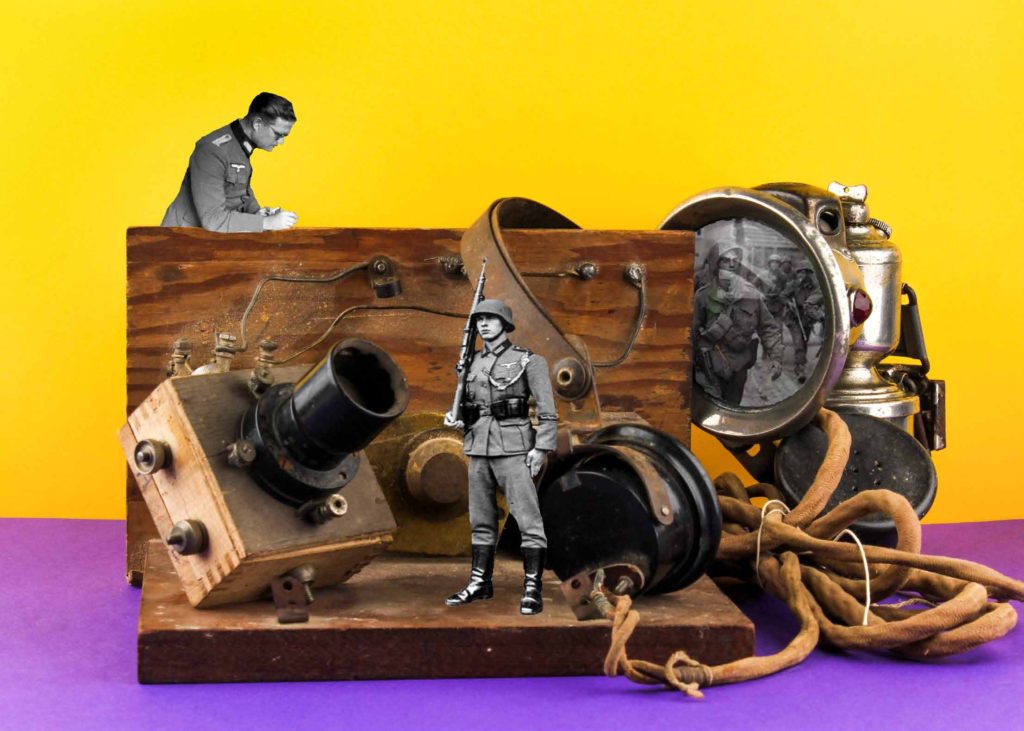
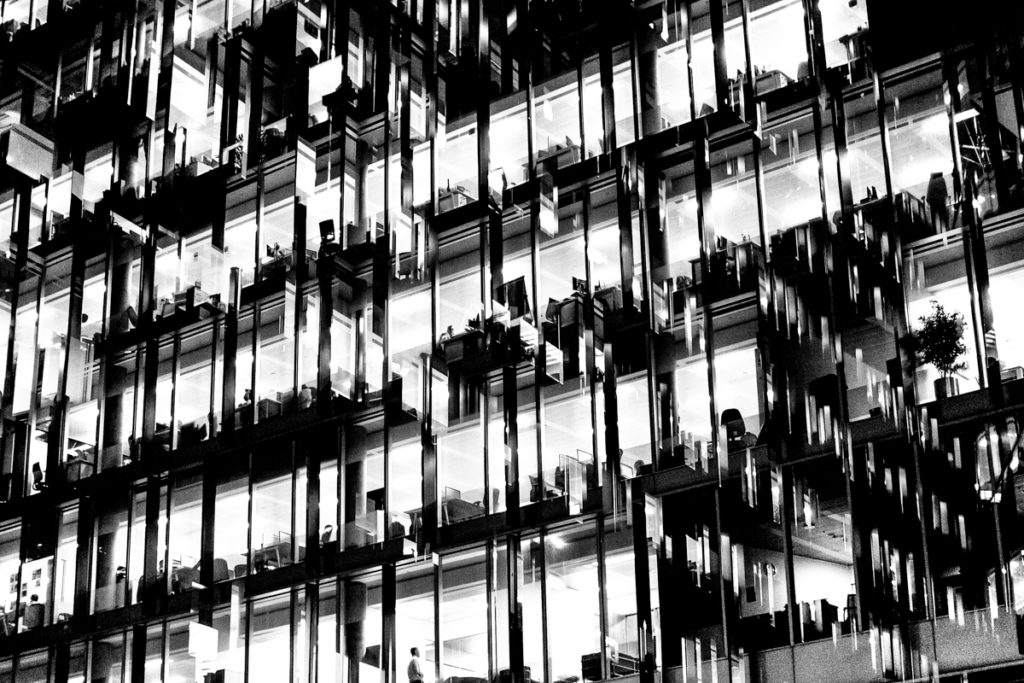
JUXTAPOSTION
Juxtaposition is placing two things together to show contrast or similarities.Look at the newspapers: LIBERATION / OCCUPATION and FUTURE OF ST HELIER produced by past students and the publication GLOBAL MARKET on the table by ECAL students for inspiration.
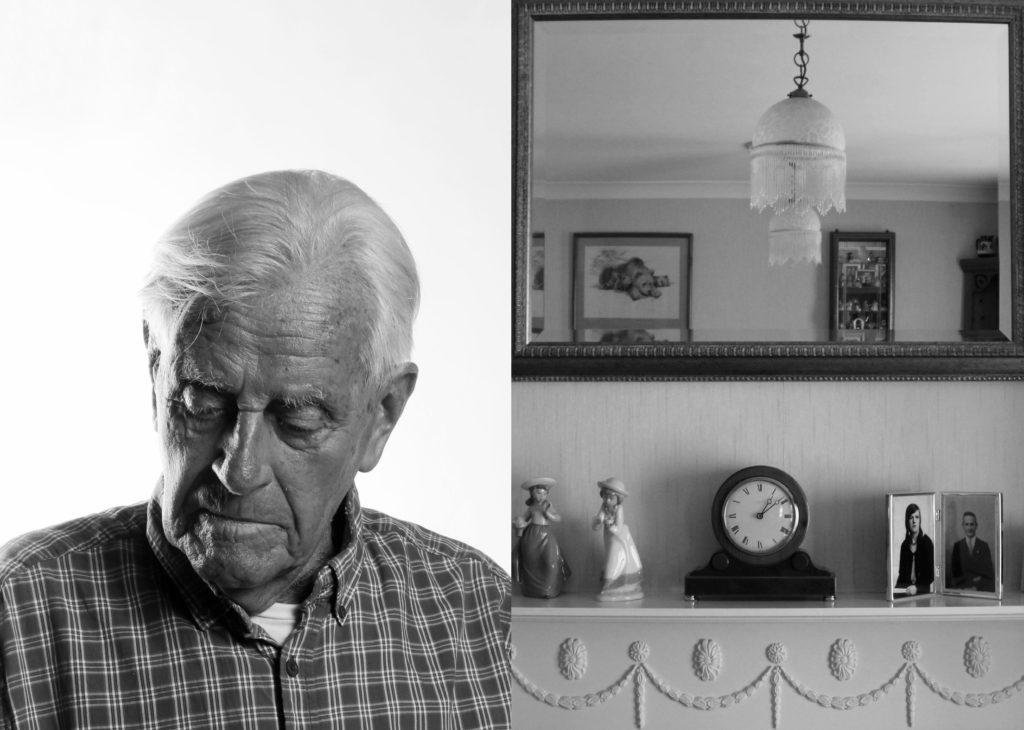
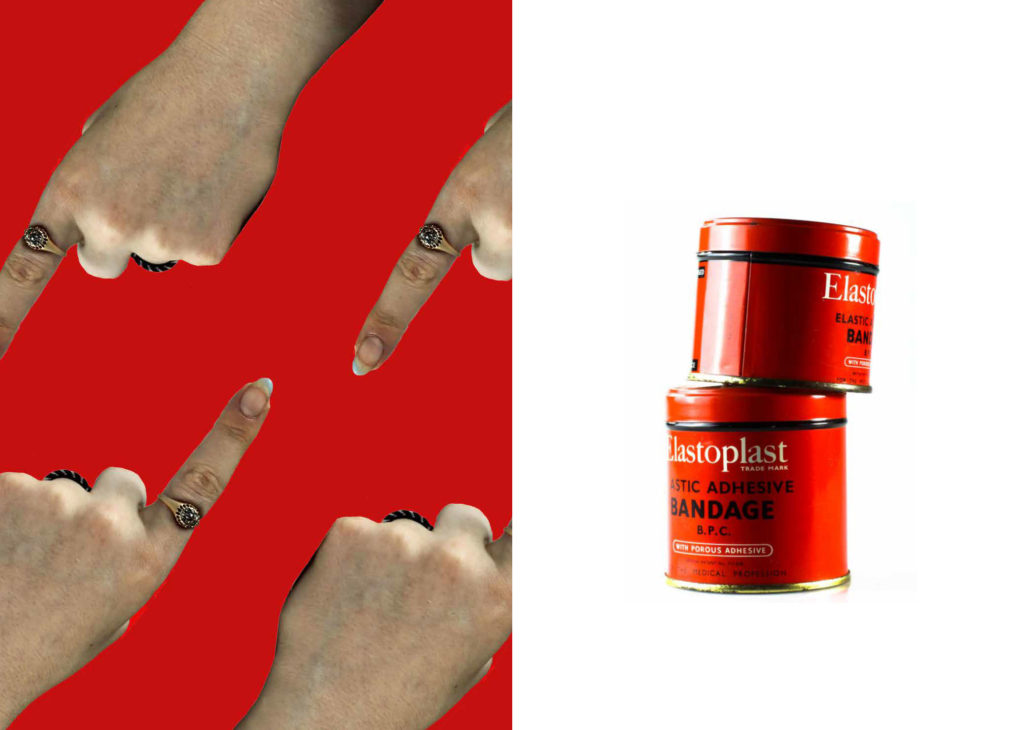

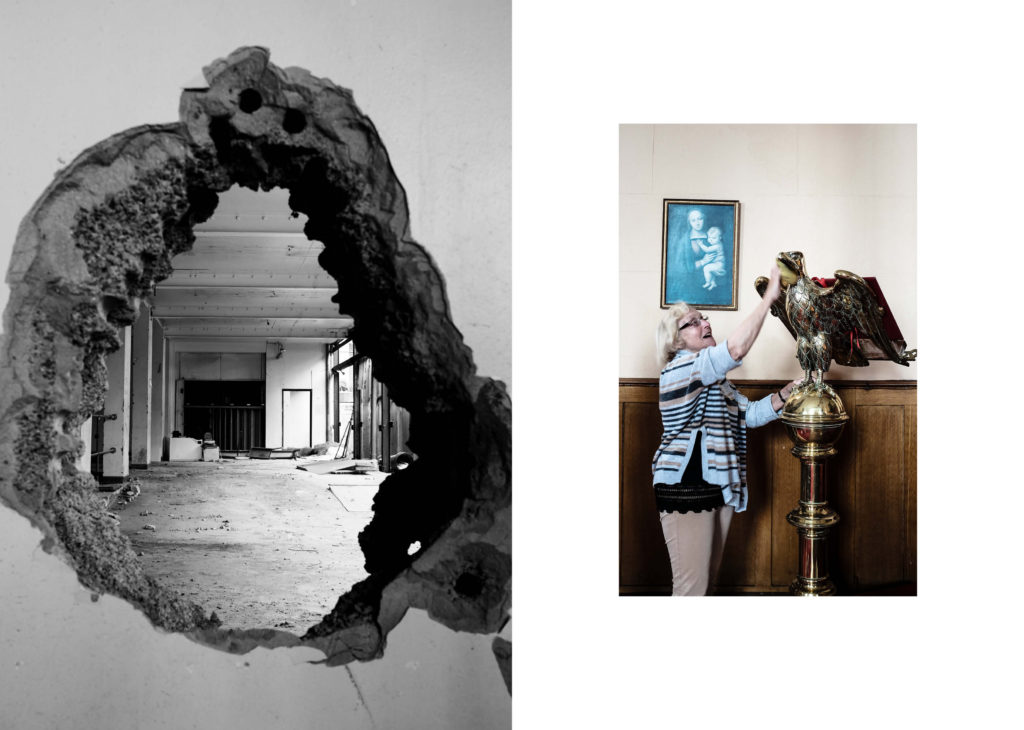



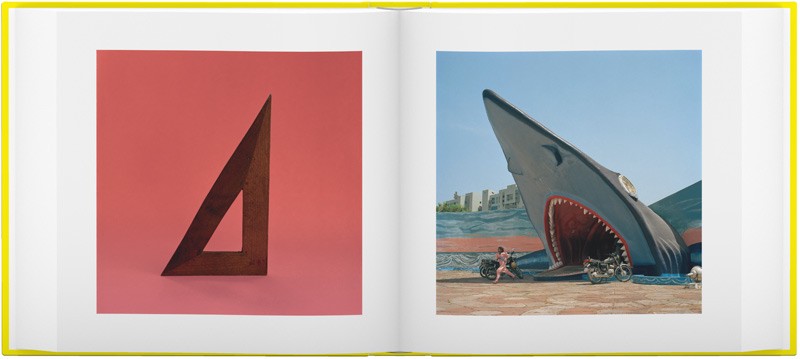
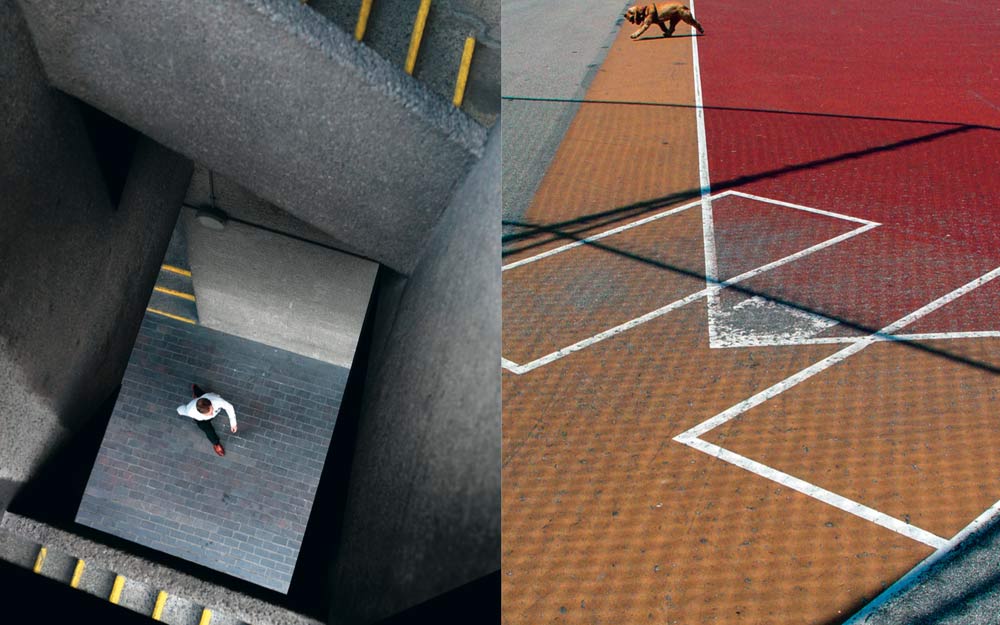

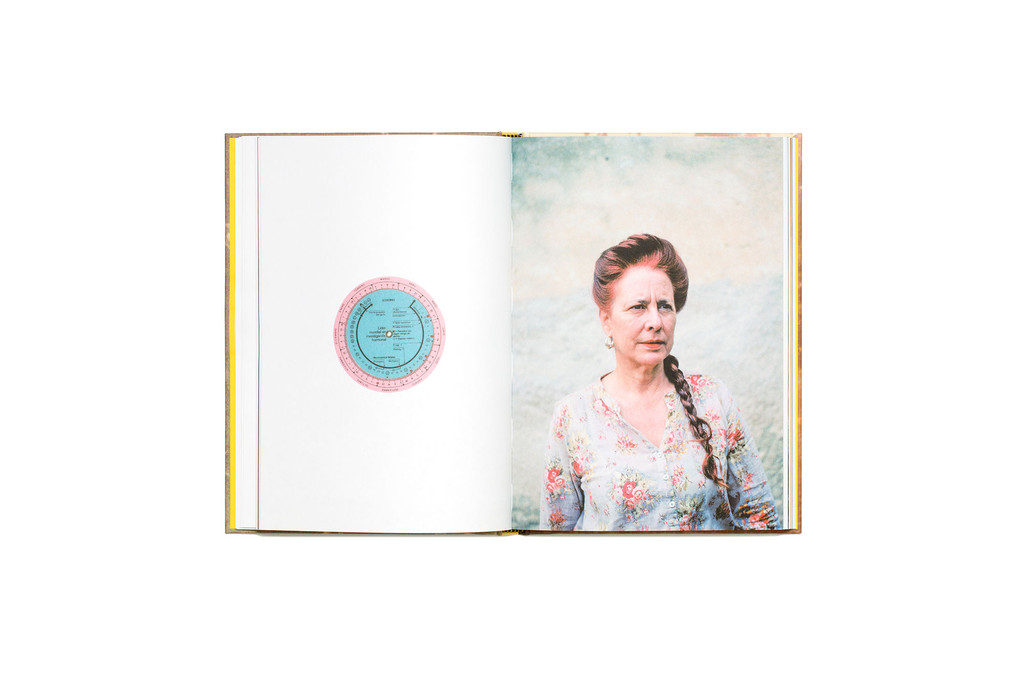
SEQUENCE
Shannon O’Donnell: That’s Not The Way The River Flows (2019) is a photographic series that playfully explores masculinity and femininity through self-portraits. The work comes from stills taken from moving image of the photographer performing scenes in front of the camera. This project aims to show the inner conflicts that the photographer has with identity and the gendered experience. It reveals the pressures, stereotypes and difficulties faced with growing up in a heavily, yet subtly, gendered society and how that has impacted the acceptance and exploration of the self.
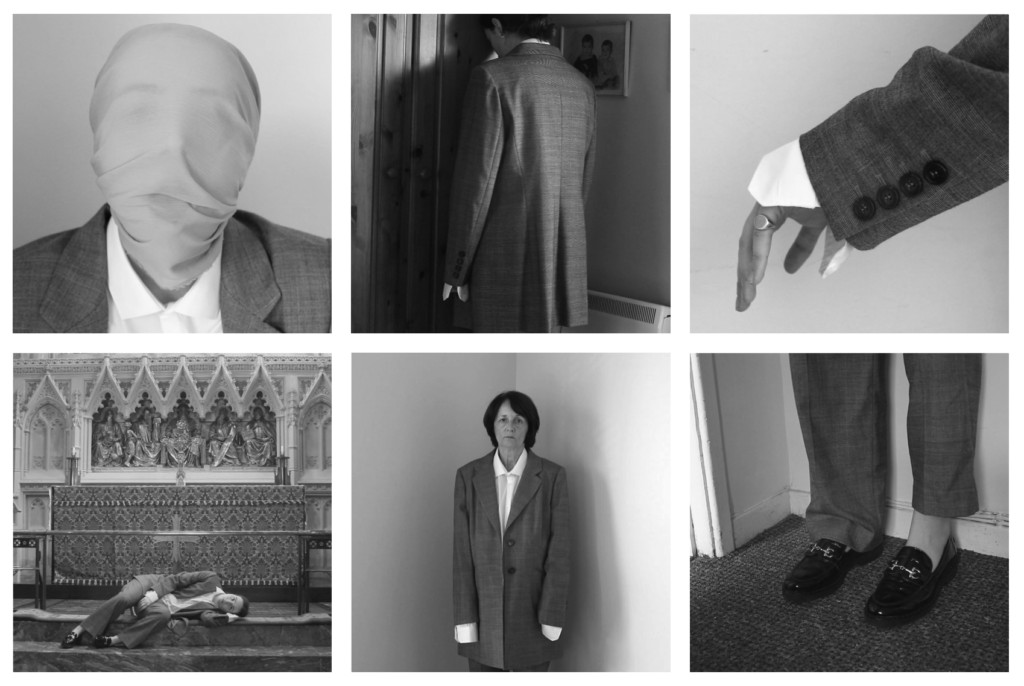
Duane Michals (b. 1932, USA) is one of the great photographic innovators of the last century, widely known for his work with series, multiple exposures, and text. Michals first made significant, creative strides in the field of photography during the 1960s. In an era heavily influenced by photojournalism, Michals manipulated the medium to communicate narratives. The sequences, for which he is widely known, appropriate cinema’s frame-by-frame format. Michals has also incorporated text as a key component in his works. Rather than serving a didactic or explanatory function, his handwritten text adds another dimension to the images’ meaning and gives voice to Michals’s singular musings, which are poetic, tragic, and humorous, often all at once.

Nine gelatin silver prints with hand-applied text
3 3/8 x 5 inches

Seven gelatin silver prints with hand-applied text
3 3/8 x 5 inches (each image)

Five gelatin silver prints with hand-applied text
3 3/8 x 5 inches (each image)
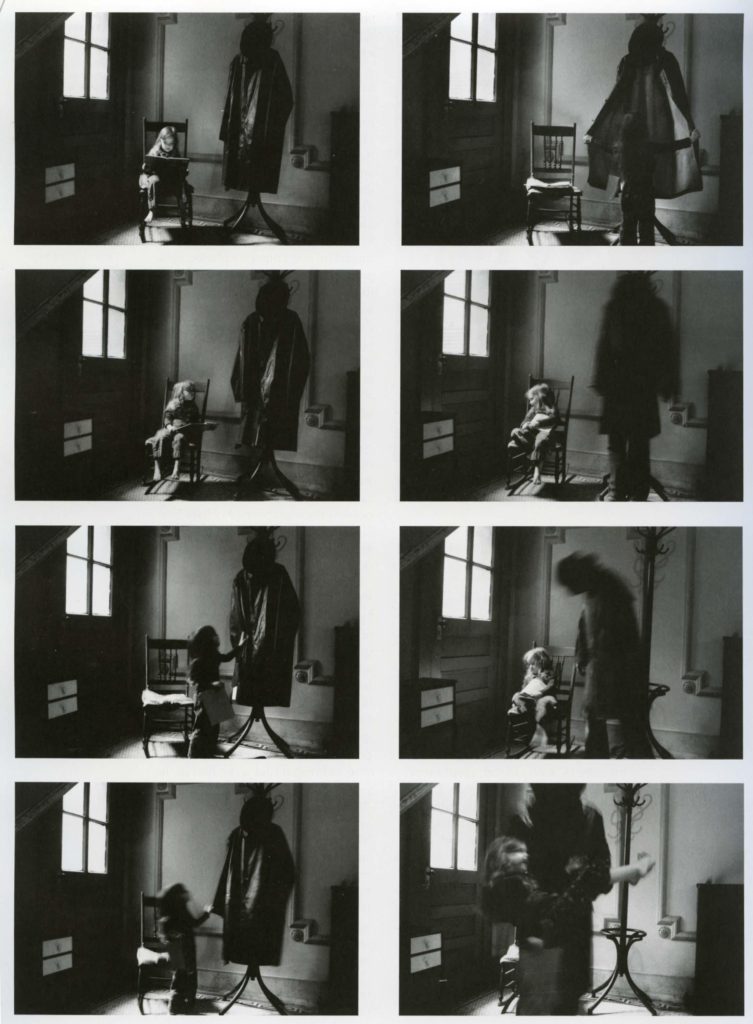
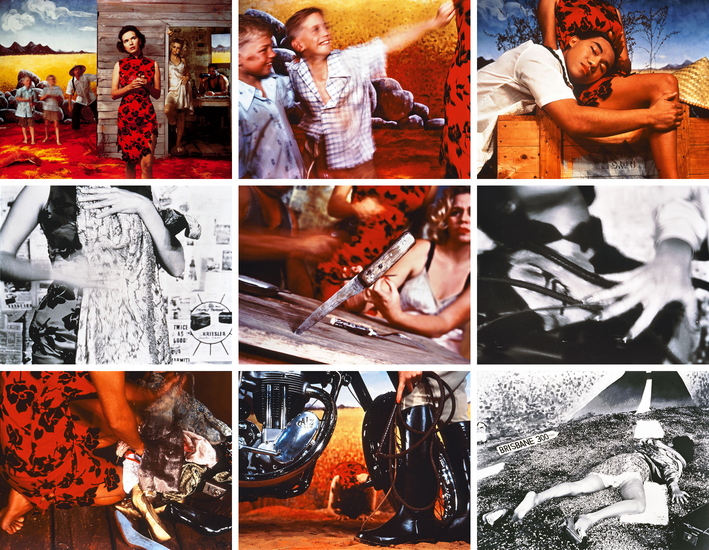
Tracy Moffatt: The nine images in Something More tell an ambiguous tale of a young woman’s longing for ‘something more’, a quest which brings dashed hopes and the loss of innocence. With its staged theatricality and storyboard framing, the series has been described by critic Ingrid Perez as ‘a collection of scenes from a film that was never made’. While the film may never have been made, we recognise its components from a shared cultural memory of B-grade cinema and pulp fiction, from which Moffatt has drawn this melodrama. The ‘scenes’ can be displayed in any order – in pairs, rows or as a grid – and so their storyline is not fixed, although we piece together the arc from naïve country girl to fallen woman abandoned on the roadside in whatever arrangement they take. Moffatt capitalises on the cinematic device of montage, mixing together continuous narrative, flashbacks, cutaways, close-ups and memory or dream sequences, to structure the series, and relies on our knowledge of these devices to make sense and meaning out of the assemblage.
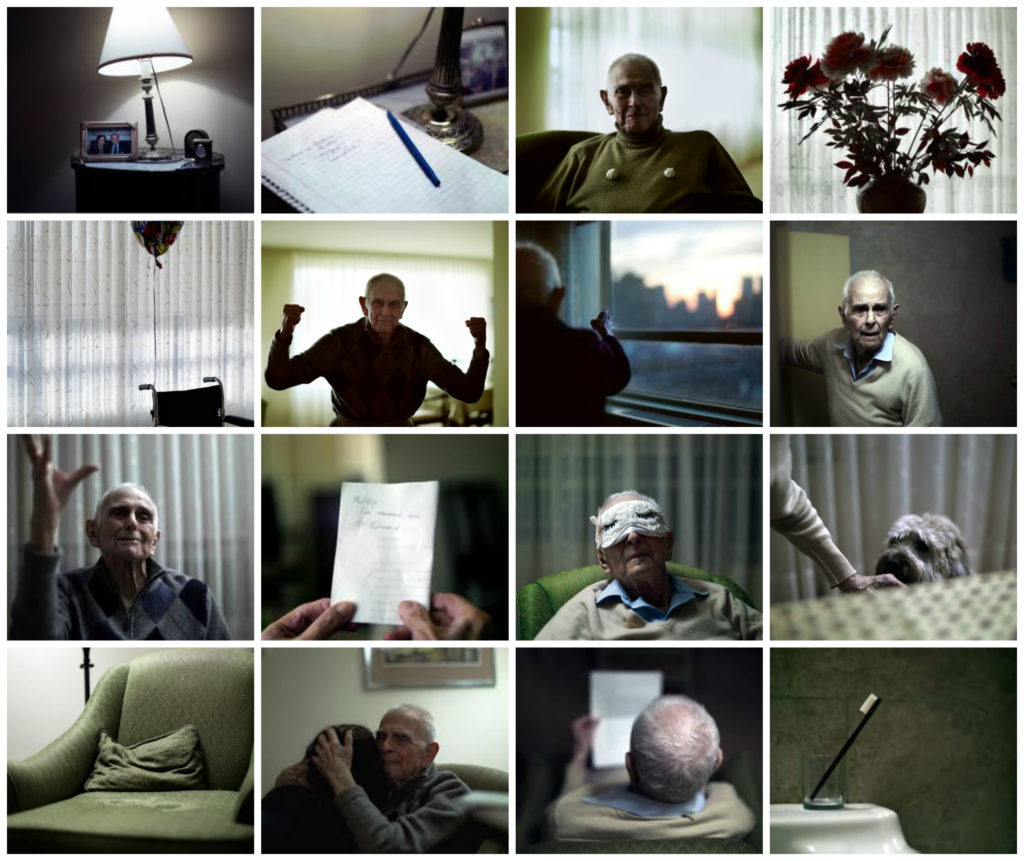
Philip Toledano: DAYS WITH MY FATHER is a son’s photo journal of his aging father’s last years. Following the death of his mother, photographer Phillip Toledano was shocked to learn of the extent of his father’s severe memory loss.
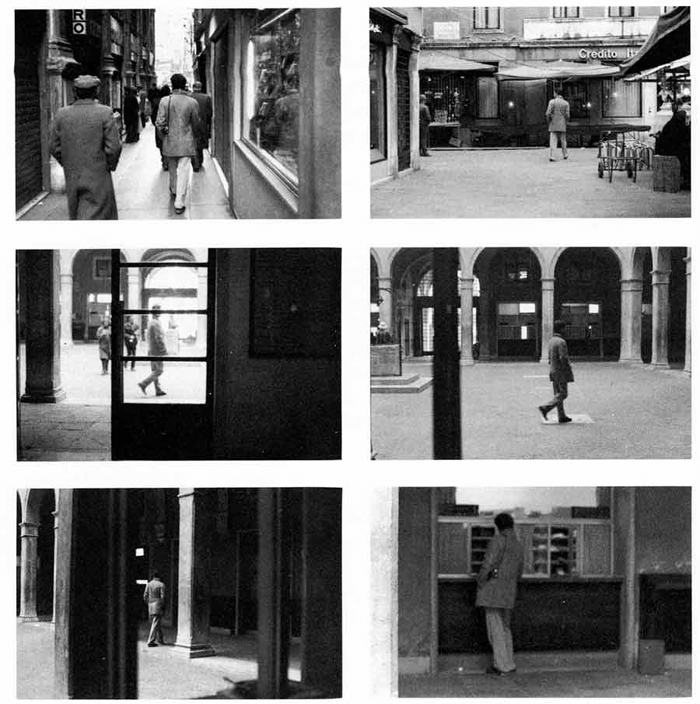
Sophie Calle’s practice is characterised by performances using rule-based scenarios, which she then documents. Venetian Suite consists of black and white photographs, texts and maps that document a journey the artist made to Venice in order to follow a man, referred to only as Henri B., whom she had previously briefly met in Paris. Although Calle undertook the journey in 1979, the texts describe the actions as taking place in 1980. Venetian Suite records Calle’s attempts to track her subject over the course of his thirteen-day stay in Venice. She investigates and stalks him, enlisting the help of friends and acquaintances she makes in the city. Eventually Henri B. recognises Calle, and they share a silent walk. Even after this encounter Calle continues her project, shadowing Henri B. from a distance until his arrival back in Paris.
The work was initially produced in book form in 1983; the same year Calle also presented the work as a sound installation in a confessional booth. In 1996 she configured Venetian Suite as a gallery-based work, the appearance of which deliberately recalls a detective casebook, with texts written in a style that mimics and deconstructs the narrative tension typical of detective novels or film noir. The text begins as follows:
For months I followed strangers on the street. For the pleasure of following them, not because they particularly interested me. I photographed them without their knowledge, took note of their movements, then finally lost sight of them and forgot them. At the end of January 1980, on the streets of Paris, I followed a man whom I lost sight of a few minutes later in the crowd. That very evening, quite by chance, he was introduced to me at an opening. During the course of our conversation, he told me he was planning an imminent trip to Venice. I decided to follow him.
(Calle and Baudrillard 1988, p.2.)
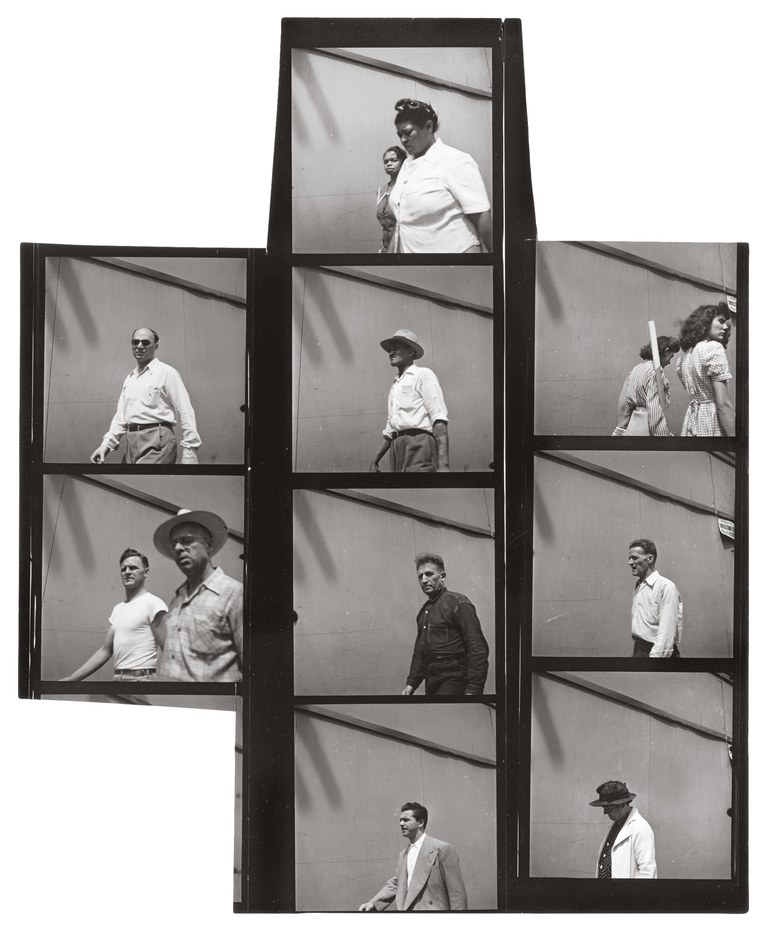
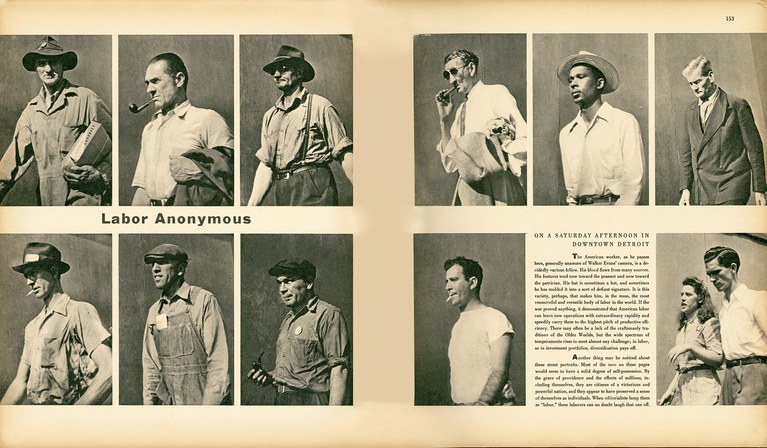
Walker Evans: One of the founding fathers of Documentary Photography Walker Evans used cropping as part of his work. Another pioneer of the photo-essay, W. Eugene Smith also experimented with cropping is his picture-stories
Read more here on Walker Evans and his magazine work and his series Labour Anonymous.

The complete set of 21 offset lithographs, on thin wove paper, with full margins,
all I. various sizes
Hans-Peter Feldmann: (b. 1941 Duesseldorf). The photographic work of Hans-Peter Feldmann began with his own publications in small print-runs between 1968 and 1975. Often using reproductions of photographs from magazines or private snapshots, which he mixed with his own photographs, Feldmann, like Ed Ruscha, undermined the aura of the unique, “authentic” work of art. With his laconic imagery he seeks to break down conventional notions of art.
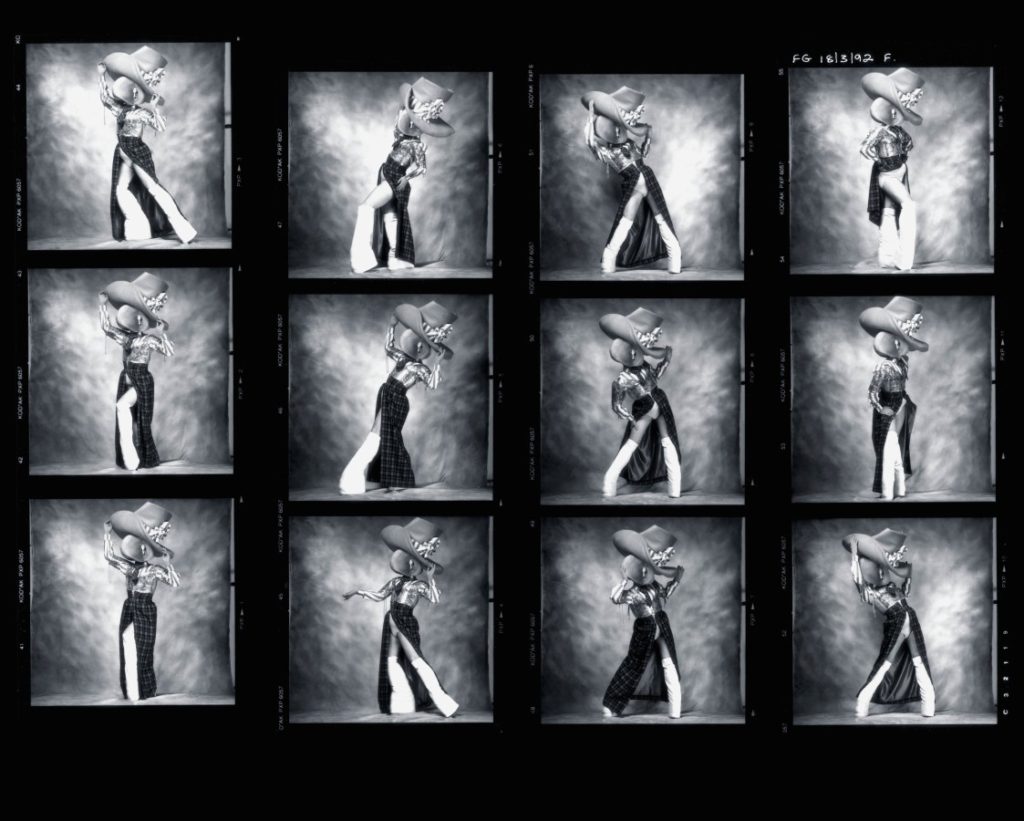
MONTAGE
Photomontage is the process and the result of making a composite photograph by cutting, gluing, rearranging and overlapping two or more photographs into a new image.
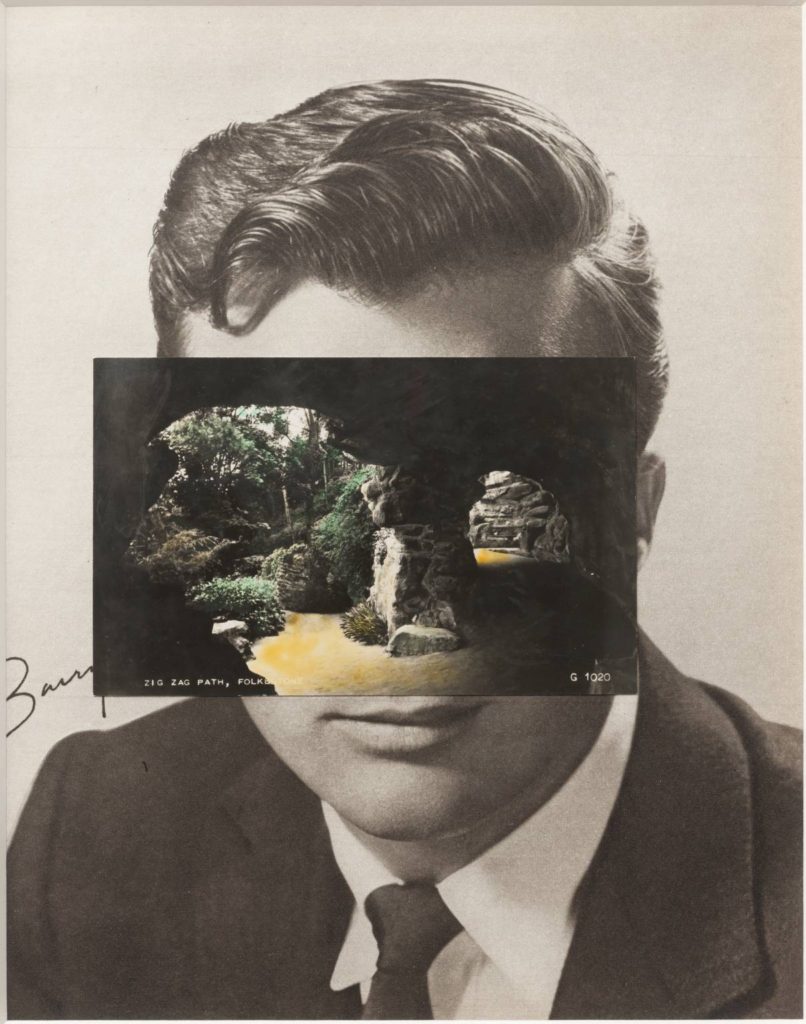
John Stezaker: Is a British artist who is fascinated by the lure of images. Taking classic movie stills, vintage postcards and book illustrations, Stezaker makes collages to give old images a new meaning. By adjusting, inverting and slicing separate pictures together to create unique new works of art, Stezaker explores the subversive force of found images. Stezaker’s famous Mask series fuses the profiles of glamorous sitters with caves, hamlets, or waterfalls, making for images of eerie beauty.
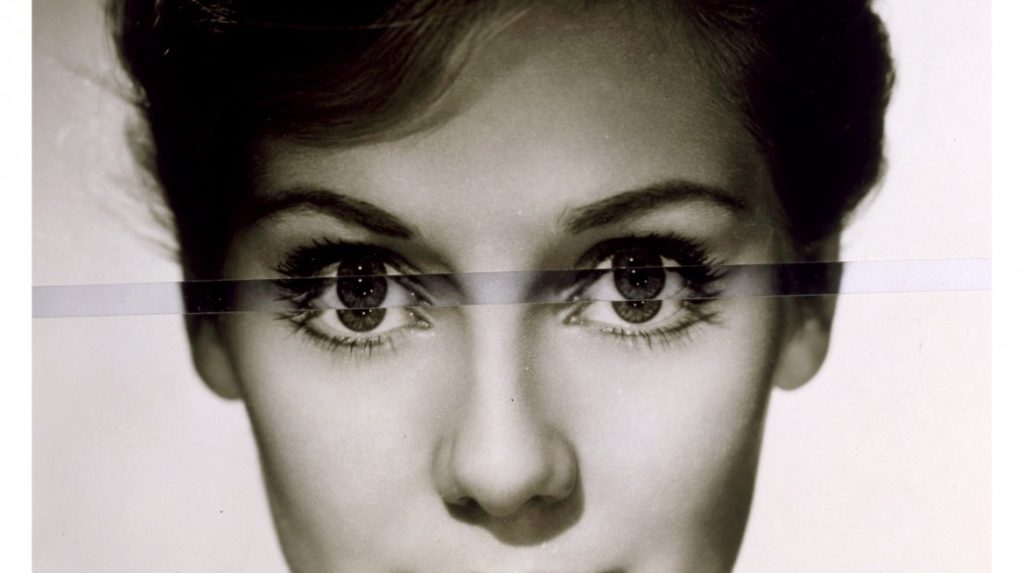
His ‘Dark Star’ series turns publicity portraits into cut-out silhouettes, creating an ambiguous presence in the place of the absent celebrity. Stezaker’s way of giving old images a new context reaches its height in the found images of his Third Person Archive: the artist has removed delicate, haunting figures from the margins of obsolete travel illustrations. Presented as images on their own, they now take the centre stage of our attention


Thomas Sauvin and Kensuke Koike: ‘No More, No Less’
In 2015, French artist Thomas Sauvin acquired an album produced in the early 1980s by an unknown Shanghai University photography student. This volume was given a second life through the expert hands of Kensuke Koike, a Japanese artist based in Venice whose practice combines collage and found photography. The series, “No More, No Less”, born from the encounter between Koike and Sauvin, includes new silver prints made from the album’s original negatives. These prints were then submitted to Koike’s sharp imagination, who, with a simple blade and adhesive tape, deconstructs and reinvents the images. However, these purely manual interventions all respect one single formal rule: nothing is removed, nothing is added, “No More, No Less”. In such a context that blends freedom and constraint, Koike and Sauvin meticulously explore the possibilities of an image only made up of itself.


Veronica Gesicka Traces presents a selection of photomontages created by Weronika Gęsicka on the basis of American stock photographs from the 1950s and 1960s. Family scenes, holiday memories, everyday life – all of that suspended somewhere between truth and fiction. The images, modified by Gęsicka in various ways, are wrapped in a new context: our memories of the people and situations are transformed and blur gradually. Humorous as they may seem, Gęsicka’s works are a comment on such fundamental matters as identity, self-consciousness, relationships, imperfection.
Checklist – all CW
Use this simplified list to check that you are on task. Every item on the list represents one piece of work = one blog post. It is your responsibility as an A-level student to make sure that you complete and publish appropriate blog posts each week. All tasks and learning resources are in the planners above.
WEEK 22: 28 Feb – 6 March
1a: PHOTOBOOK: Write a book specification; narrative, concept and design + moodboard of layout & design ideas
1b: FILM: Storyboarding; shot-by-shot sequence, narrative and mise-en-scene + moodboard of films and editing ideas.
2: RECORDING: Selection, editing, experimentation and evaluation of new photoshoots (one blog posts per shoot)
3: PLANNING: Evaluate current images made and produce new images/ photoshoots if needed.
Week 23: 7 – 13 March
1. NEWSPAPER SPREADS: Design 3-4 versions of a newspaper spreads based on images from both your current and previous projects.
You must design the following spreads:
- FULL-BLEED: Select one image as a full-bleed spread.
- JUXTAPOSITION: Select 2 images and experiment with different combinations.
- SEQUENCE: Select a series of images (between 4 – 12) and produce a sequence either as a grid, story-board, contact-sheet or typology.
- MONTAGE: Select an appropriate set of images and create a montage of layered images. You may to choose to work in Photoshop for more creativity and import into InDesign as one image (new document in Photoshop 400mm(h) x 280.5mm(w) in 300 dpi)
See blog post here for information and inspiration
Newspaper | 2022 Photography Blog (hautlieucreative.co.uk)
WEEK 24: 14 – 20 March
1. PHOTOBOOK/ FILM: Continue to develop and show clear progression of your design/ editing process, including prints screens of layout with annotation (ongoing.)
2. PORTFOLIO: Review your folder and make sure you have a good selection of final outcomes incl: zine, NFT film + image, final prints, essay and photobook/ film.
Week 25: 21 – 27 March > Study Leave
1. BLOGPOSTS: Complete any outstanding blogposts as per tracking sheet
2. PLANNING & RECORDING: Final chance for making new images/ photoshoots.
Week 26: 28 March – 3 April
1. PHOTOBOOK/ FILM: Continue to work on photobook design/ film editing – make sure your document design/ editing process, including prints screens of layout with annotation (ongoing.)
2. PORTFOLIO: Review your folder and make sure you have a good selection of final outcomes incl: zine, NFT film + image, final prints, essay and photobook/ film.
3. FINAL PRINTS: Select 5-7 prints and consider presentation producing mock up in Photoshop and/or create virtual gallery.
Week 27: 4 – 8 April > MOCK EXAM
1a: PHOTOBOOK: Complete design and include essay in Blurb.
1b: FILM: Complete editing film, export and embed on blog.
2. PRESENTATON: Mount and present final images
3. EVALUATION: write an evaluation and create virtual gallery of final prints.
4. BLOGPOSTS: Review all blogposts and complete/ improve as per tracking sheet.
Mon 4 – Wed 6 April: Class 13B
Thur 7 – Fri 8 April: Class 13C
DEADLINE: LAST DAY OF YOUR MOCK EXAM
ALL CW: PHOTOBOOKS / FILM > PRINTS > BLOG POSTS
Mock exam guidance
Mon 7 – Wed 9 Feb: Class 13B
Thur 10 -Fri 11 – Mon 14 Feb: Class 13C
DEADLINE: LAST DAY OF YOUR MOCK EXAM
ESSAY > PHOTOBOOKS / FILM > BLOG POSTS
IN PREPARATION FOR MOCK EXAM MAKE SURE THE FOLLOWING IS READY BY THE END OF THIS WEEK:
- Complete and proof read essay draft this week (so there is enough time to make final corrections and incorporate it into book design in Mock exam.)
- Upload new photoshoots and edit in Lightroom – make sure to produce blog posts showing selection process and experimentation of images.
- A draft layout of your photobook/ rough cut of film edit before your Mock Exam begin (that time is used to fine tune design with teacher)
- Make sure you monitor and track your progress by Fri 4 Dec using planner and tracking sheet below and publish on blog.
PLANNER – Download and save in your folder. Make sure you monitor and track your progress.
Structure your 3 day Mock Exam as follows:
DAY 1:
Essay: Complete essay, incl illustrations, referencing and bibliography + publish on blog (essay also needs to be added and presented at the end of your photobook)
DAY 2:
Photoshoots/ recordings: Begin editing images or recordings for your photobook / film + produce blog posts showing selection process and experimentation of images. Use a combination of print screens + annotation. Write an evaluation about what went well and what you need to do next to develop your shoots and project.
DAY 3
Photobook/ film: Begin photobook design/ edit film + produce blogpost showing design process and evaluate. Use a combination of print screens + annotation.
Prints: Begin to consider final prints and produce blog post showing presentation ideas and create mock-up in Photoshop and virtual gallery.
Blogposts: Finish and publish any missing blog posts as per Planner and your tracking sheet.
ESSAY
Publish final essay as a separate blog post with illustrations of key works by artists and your own images analysed in your text, as well as a bibliography listing all literary sources used. Also incorporate essay in the back of your book using layout in text columns and include illustrations and bibliography.
PHOTOBOOK
Make sure you have a made a blog post that charts your design decisions, including prints screens of layout with annotation and write an ongoing evaluation. If you complete it; final book design must be checked and signed off by teacher.





For more help and guidance editing, process and evaluation go to blog post below.
BLURB – ORDER BOOK
Inside Lightroom upload book design to BLURB, log onto your account on their website, pay and order the book.
Consider spending a few extra pounds on choosing better paper, such as Premium Lustre in check-out, change colour on end paper or choose different cloth/ linen if needed.

FILM
Make sure you have a made a blog post that charts your editing process, including prints screens with annotation and write an evaluation. If you complete it; final film must be checked and signed off by teacher.
For more help and guidance on editing, process and evaluation go to blog post below.
Export final film as mp4 file and upload to Youtube / Microsoft Streams and embed on Blog. Follow these steps:
- In Premier: Click on Sequence > Render IN/OUT
- File > Export > Media
- Export Settings: Format H.264
- Output Name: use title of your film and save to V:Data drive
- Click Export at bottom
- Using Microsoft Stream: Open up Office 365
- Go to All Apps and select Stream
- Create > Upload Video
- Browse to upload your exported film from V:Data drive
- Write a short description, choose thumbnail and publish
- My Content > Videos > embed film into Blog post with evaluation.
- In Youtube: Set up an account at home (www.youtube.com)
- Click Create (top right corner) > Upload video
- Select file > your exported film from V:Data drive
- Write a short description and choose thumbnail
- Once uploaded, embed film into Blog post with evaluation.
BLOGPOSTS
All blog posts in relation to the above must be published, including any other posts missing from previous work modules since the beginning of A2 academic year, including Zines which must be printed & bound, and NFT film and digital image, including a statement, uploaded to both blog and folders here ready for the exhibition:
M:\Departments\Photography\Students\Image Transfer\IDENTITY & COMMUNITY\NFT
See previous student, Stanley Lucas as a guide on blogposts that needs to be done and published before you the end of your Mock Exam
https://hautlieucreative.co.uk/photo19al/author/slucas08
FINAL PRINTS
Select your final prints (5-7) from photobook/ film and make a blog post showing ideas about how to present them.
In photoshop produce a mock display (create new document size A1: 594 x 841mm) using different image sizes, for example: A3 x 2, A4 x 2, A5 x 3

PREPARE AND SAVE IMAGES FOR PRINTING:
- Add your images to the print folder here…M:\Departments\Photography\Students\Image Transfer\Printing Yr 13 IDENTITY
- Complete any unfinished work from last term if you have time, For example: select images for print form Zine and NFT projects.
File Handling and printing...
- Remember when EXPORTING from Lightroom you must adjust the file size to 1000 pixels on the Short edge for “blog-friendly” images (JPEGS)
- BUT…for editing and printing when EXPORTING from Lightroom you must adjust the file size to Short edge for “high resolution” images (JPEGS) like this…

- A5 Short Edge = 14.8 cm
- A4 Short Edge = 21.0 cm
- A3 Short Edge =29.7 cm
This will ensure you have the correct ASPECT RATIO
Ensure you label and save your file in you M :Drive and then copy across to the PRINT FOLDER / IMAGE TRANSFER
For a combination of images, or square format images you use the ADOBE PHOTOSHOP > NEW DOCUMENT + PRINT PRESETS on to help arrange images on the correct size page (A3, A4, A5)
You can do this using Photoshop, Set up the page sizes as templates and import images into each template, then you can see for themselves how well they fit… but remember to add an extra 6mm for bleed (3mm on each side of the page) to the original templates. i.e. A4 = 297mm x 210 but the template size for this would be 303mm x 216mm.

Making a Virtual Gallery in Photoshop
Download an empty gallery file…then insert your images and palce them on the walls. Adjust the persepctive, size and shape using CTRL T (free transform) You can also add things like a drop shadow to make the image look more realistic…


…or using online software
How I did it:
Step 1: Go to www.artsteps.com
Step 2: Sign in / up.
Step 3: Create.
Step 4: Create your own location or choose a template.
Step 5: Upload your images, put them in your exhibition, name it and give it a description.
Step 6: Present / view your Exhibition.
checklist: personal study
CHECKLIST – PERSONAL STUDY
Use this simplified list to check that you are on task. Every item on the list represents one piece of work = one blog post. It is your responsibility as an A-level student to make sure that you complete and publish appropriate blog posts each week. All tasks and learning resources are in the planner above.
WEEK 10: 15-21 Nov
Island Identity
WEEK 11: 22-28 Nov
1. Review and Reflection
2. Mindmap
3. Moodboard
Week 12: 29 Nov – 5 Dec
1. Statement of Intent
2. Artists References – at least two
3. Planning & Recording: Shoot 1 – response to initial idea
4. Contextual Studies 1: Conversations on Photography – publish by Wed 8 Dec
Week 13: 6 – 12 Dec
1. The origins of photography: write 500 -1000 words + illustrations
2. Planning & Recording: Shoot 2 – response to early photographic processes or your own project
Week 14: 13 Dec – 5 Jan
1. Art movements and isms: write 500 – 1000 words + illustrations
2. Planning & Recording – at least 3 photoshoots in response to your project. what, why, how, when, where? Bring images with you in the New Year.
3. Self-assessment: Review your work using traffic light system and publish on blog by Fri 17 Dec.
XMAS Break:
1. RECORDING: Produce a number of photographic response to your Personal Study and bring images from new photo-shoots to lessons in January.
2. READING: Key texts (interviews, reviews, articles etc.) about your subject, photo-history and chosen artists in preparation of writing your essay in January.
Week 15: 5 – 9 Jan
1. Literary Sources
2. Essay Question
3. Essay Plan
Week 16: 10 – 16 Jan
1. Essay: Introduction
2. Essay: Paragraph 1
3. Practice: Edit photoshoots and evaluate
Week 17: 17 – 23 Jan
1. Essay: Paragraph 2 & 3
2. Practical work: Define Story & Narrative
3a: Photobook: Select book and deconstruct narrative, concept and design
3b: Film: Select film and deconstruct narrative, editing and sound
Week 18 – 19: 24 Jan – 4 Feb
1. Essay: Conclusion, bibliography, proof-read and hand in draft Mon 31 Jan
2a: Photobook: Write a book specification; narrative, concept and design
3b: Photobook: Moodboard and create Blurb account
2b: Film: Storyboarding; narrative, visuals and sound
3b: Film: Moodboard and begin editing
Week 20: 7 – 11 Feb MOCK EXAM
1. Essay: Publish final essay with illustrations and a bibliography
2a: Photobook: Complete design and include essay in Blurb
2b: Film: Complete editing film, export and embed on blog
3. Print: Select a set of 5-6 final prints for mounting
4. Blog: Review and complete all supporting blogposts
5. Statement: write 100-200 words and save in folder
Final outcomes & Deadlines:
Essay (2000 words): 28 Jan 2022
Photobook / Film / Prints: Last day of Mock Exam
GP 13B: Wed 9 Feb
GP 13C: FRI 11 FEB
Week 21: 14 – 18 Feb + H-TERM
1. Photoshoots: Selection, editing, experimentation and evaluation (from each shoot.)
2. Planning & Recording: Evaluate current images made and produce new images/ photoshoots for half-term.
3. Deconstruct Photobook: Select book and analyse narrative, concept and design (from week 17)
4. Book Specification: define narrative, concept and design for your book + moodboard of design ideas (from mock exam.)
5. Photobook Design: Clear progression of your design process, including prints screens of layout with annotation (ongoing.)
Island Identity
Tue 15 Feb: Complete this Island Identity Survey
The survey has been commissioned to conduct some research to explore the integration of ethnic and minority communities in Jersey to fulfill one of the recommendations that was made in the summary report of the Island Identity Policy Development Board published last year. A short survey has been designed to gather views on this issue and on the themes of belonging and identity.
This survey is part of the Island Identity project that was commissioned by Deputy Carolyn Labey, Assistant Chief Minister, Minister for International Development and Chair of the Island Identity (IID) Policy Development Board. On Tuesday 15 Feb they have arranged an event Jersey Dialogues – Exploring and Celebrating Our Island Idenity at Radison Blu Hotel with the formal programme running from 1:30 to 5:30 pm includes talk and workshops with high profile speakers.

personal study planner
A-Level Coursework
The A-level coursework consist of two modules, Personal Investigation (worth 72 marks) and Personal Study (essay worth 18 marks) which are interlinked and informed by each other. All the work that you produced (both coursework and exam) in Yr 12 also contributes towards A-Level coursework and overall equates to 100% of the total marks as there will be no External Set Assignment (Exam) in 2022. The Personal Study essay account for 25% of the total marks. The last week before H-Term 7-11 Feb is a Mock Exam and will count as final DEADLINE
What is a Personal Study?
The aim of this unit is to critically investigate, question and challenge a particular style, area or work by artists/ photographer(s) which will inform and develop your own emerging practice as a student of photography. The unit is designed to be an extension of your practical work in your Personal Investigation module where the practical informs and develops the theoretical elements and vice versa of your ongoing project.
Your Personal Study is a written and illustrated dissertation, including a written essay (2000 words) and a lens-based body of work (either stills photography or moving image) with a number of final outcomes produced from your Personal Investigation unit.
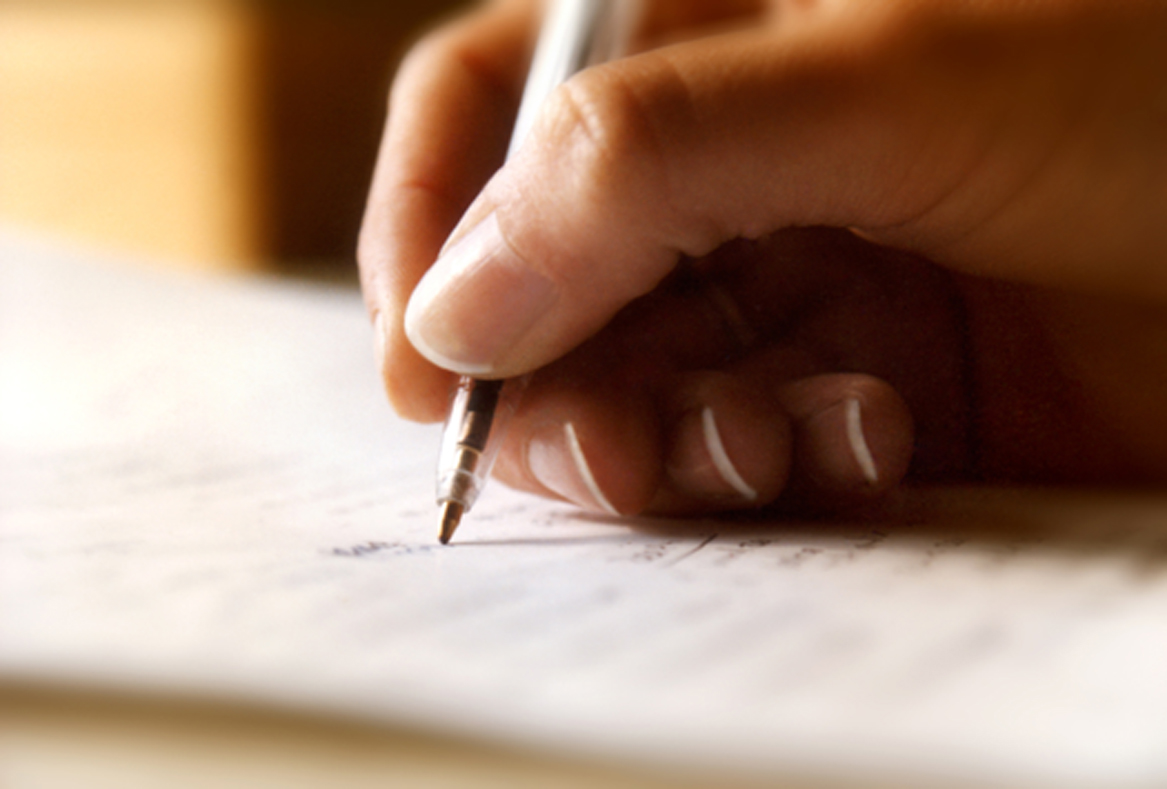
Links to a previous essays:
Emma Price: In what way have Jim Goldberg and Ryan McGinley represented youth in their work?
Lawrence Bouchard: What Constitutes a ‘Real’ Image?
Thomas Le Maistre: How do Robert Mapplethorpe and Karlheinz Weinberger portray ‘Lad Culture’ through the medium of portraiture?
This year you have a choice to make either a film (3-5mins) or a photo book, either online using Blurb or by hand using traditional book binding techniques, which you design to include both your essay and a final selection and sequence of your photographs produced as a response to your chosen theme(s) of IDENTITY & COMMUNITY.

In addition, you are expecting to produce an appropriate amount of blogposts that demonstrates your ability to research, analysis, plan, record, experiment, present and evaluate.
What it says in the syllabus (Edexcel)
- Essential that students build on their prior knowledge and experience developed during the course.
- Select artists work, methods and art movements appropriate to your previous coursework work as a suitable basis for your study.
- Investigate a wide range of work and sources.
- Develop your written dissertation in the light of your chosen focus from the practical part of previous coursework and projects.
- Establish coherent and sustainable links between your own practical work with that of historical and contemporary reference.
- Be aware of some of the methods employed by critics and historians within the history of art and photography.
- Demonstrate a sound understanding of your chosen area of study with appropriate use of critical vocabulary.
- Show evidence for an ongoing critical and analytical review of your investigation – both your written essay and own practical work in response to research and analysis.
- Develop a personal and critical enquiry.
- Culminate in an illustrated written presentation.
How to get started: Link your chosen area of study to your previous work, knowledge and understanding based upon your chosen theme(s) of IDENTITY & COMMUNITY
Up until now you have explored the theme of COMMUNITY in class and produced two different outcomes; a photo-zine and a short film. Both outcomes are exploring narrative in different ways and it’s up to you to decide which theme and medium you enjoy most and feel will give you the best chance at producing a quality final outcome. This project will be the final chance you have to improve your marks and grades!
You can decide to continue to respond to/ investigate the theme of COMMUNITY in a similar or different way, or take a fresh look at the theme of IDENTITY, either as way to explore who you are as an individual or examine aspects of Jersey’s history, culture and heritage that gives the island its unique identity.
The choice is between making a photobook; exploring a subject and theme in depth using photography as a tool for visual storytelling, either through observation (documentary) or staging (tableaux) a series of photoshoots. Making a film might be more in line with your creative skills set and offer other elements to storytelling, such as moving image and sound. Either option offers its own unique set of challenges and opportunities for you to express yourself creatively as A-Level Photography student.
The work that you produce will also be presented collectively to a large audience in April/ May next year as a newspaper; printed and distributed island-wide by the Jersey Evening Post.
In this module we will examine how different narrative structures can be used to tell stories in pictures from looking at photobooks as well as cinema. We will consider narrative within a documentary approach where observation is central in representing reality, albeit we will look at both visual styles within traditional photojournalism as well as contemporary photography which employs a more poetic visual language that straddles the borders between objectivity and subjectivity, fact and fiction.
Some of the subjects you wish to explore within the themes may relate to issues already represented and interpreted in your work, for example RACE, GENDER, FAMILY, EQUALITY and ENVIRONMENT. It may be useful for you to revisit some of the parts we have already covered so far in our coursework.
PRACTICAL WORK: You have 8 weeks in lesson time and over 2 weeks at Christmas to complete principal shoots and make new images. This include all relevant blog posts demonstrating your knowledge and understanding of: RESEARCH > ANALYSIS > PLANNING > RECORDING, EXPERIMENTATION > PRESENTATION > EVALUATION.
PHOTOBOOK: Returning after Christmas we will be spending the whole month of January developing, designing and printing the photobook which will include your essay and somewhere between 40-60 images sequenced to tell a story.
FILM: If you are making a film, then you will be spending January editing your footage, including both visual (moving image/ still-images) and sound (voice-over, sound effects, ambient sound, music scores). Your essay will be published as a separate blog post.
DEADLINE: MUST complete 3-4 new photo-shoots/ moving image recordings this AUTUMN TERM that must be published on the blog by Tue 5 Jan 2022.
ESSAY: We will be spending minimum 1 lesson a week on CONTEXTUAL STUDIES where you will be learning about art/photo history, critical theory and contemporary practice as well as developing academic study skills to help you writing your essay. However, it is essential that you are organising your time effectively and setting aside time outside of lessons to read, study and write.
DEADLINE: Final Essay MUST be handed in Fri 28 Jan 2022
MOCK EXAM: 7 – 11 Feb 2022. 3 days controlled test (15 hours)
Groups: 13B: MON 7 – WED 9 FEB
13C: WED 7 – FRI 11 FEB
DEADLINE: Completion of photobook or film
LAST DAY OF YOUR MOCK EXAM.
NEWSPAPER: From the work that you produce as part of this unit we will be making a collective newspaper based on the two themes of IDENTITY & COMMUNITY.
DEADLINE: 8 APRIL 2022
Week 10: 15 – 21 Nov
Introduction to Personal Study
Island Identity
ISLAND IDENTITY
What makes Jersey special and why does that matter? These two simple-sounding questions underpin the creation of a new ISLAND IDENTITY project led by Deputy Carolyn Labey, Deputy of Grouville, Assistant Chief Minister and Minister for International Development. The newspaper we will be producing together as a class will be sponsored by the Minister who will also provide a foreword.
RATIONALE: Our national Identity – how we see ourselves and how others see us – matters a great deal. In Jersey, our ability to work together, care for each other, grow our economy and look after our environment depends on us being bound to each other by more than a shared geography and set of rules. Whatever our backgrounds or occupations, we can benefit from a shared sense of belonging and a shared understanding of what it means to be Jersey.
The ISLAND IDENTITY project has produced a website and a report that has identified distinctive qualities of island life in Jersey. You may wish to explore one of those key themes more in-depth as a concept for your project. They are:
Constitution & Citizenship
Communities
International
Economy
Education & Sport
Heritage, Culture & the Arts
Environment
Lessons MON-FRI: ISLAND IDENTITY PROJECT
TASK: In groups of two produce a poster that reflects on one of the key areas listed above.
- Research the topic thoroughly using resources listed on the Island Identity website
- Watch Island Identity Film
- Read report: What does Jersey Mean to You?
- Consider these four questions in Island Identity Survey
1. What makes Jersey special and why does it matter to you?
2. What does it mean to be ‘Jersey’, now and in the future?
3. What can we all do to solidify a cohesive and positive Island identity?
4. Are there barriers to a positive and inclusive Island identity? (What requires a greater focus and what is being missed?)
- Consider ways you could explore the topic through photography and/or film.
- Develop a concept and provide a number of creative starting points for a project.
- Poster must be visually stimulating using a combination of images, graphics and text.
- Present your poster and ideas in class by Fri 19 Nov.
- Publish poster on the blog and write an evaluation by Mon 22 Nov.
CONSIDER ISLAND IDENTITY: Jersey’s natural landscape, Medieval architecture and castles, Neolithic structures and archaeology, German fortifications, influence of Norman culture and language; ie. cultural festivals/ social rituals/ Jérriais speakers/ place names, agricultural heritage; Jersey cow, Royal potato, cider making, knitting, maritime history; privateering, North Atlantic cod-fisheries, worldwide merchant trade, ship building, International Finance Centre; tax heaven, Tourism; a Victorian seaside retreat, 1960s, 70s and 80s heyday of mass tourism
Week 11: 22 – 28 Nov
Developing Personal Study
Review and Reflect
Lesson task MON: Personal Investigation
Choose one final project from past students.
For photobooks, look through sequence of images carefully and study their supporting blog posts.
For films, watch film saved in shared folder here and study their supporting blog posts.
M:\Departments\Photography\Students\Image Transfer\LOVE & REBELLION\FILM\Personal Study
Present their project in class and comment on the book, or film’s quality, with reference to:
Concept
Editing
Sequencing
Design
Narrative
Aesthetic
Make an assessment using the mark sheet below and calculate a grade.
Lesson task TUE: Personal Study
Read the essay and comment on its overall written and interpretative quality as well as its use of critical, contextual and historical references, eg.
- Does the essay address its hypothesis?
- Does it provide new knowledge and understanding?
- Is the essay well structured with a sense of an introduction, paragraphs and a conclusion?
- Use and flow of language, prose, punctuation, spelling.
- Use of specialist vocabulary relating to art and photography.
- Analysis of artist’s oeuvre (body of work) and key work(s).
- Evidence of wider reading with reference to art history/ theory, political discourse and/or socio-economical context.
- Use of direct quotes, summary or commentary from others to make an informed and critical argument.
- Use of referencing system (eg. Harvard) and a bibliography.
- Use of illustrations with captions listing name of artist, title of work and year of production.
Make an assessment using the mark sheet and calculate a grade.

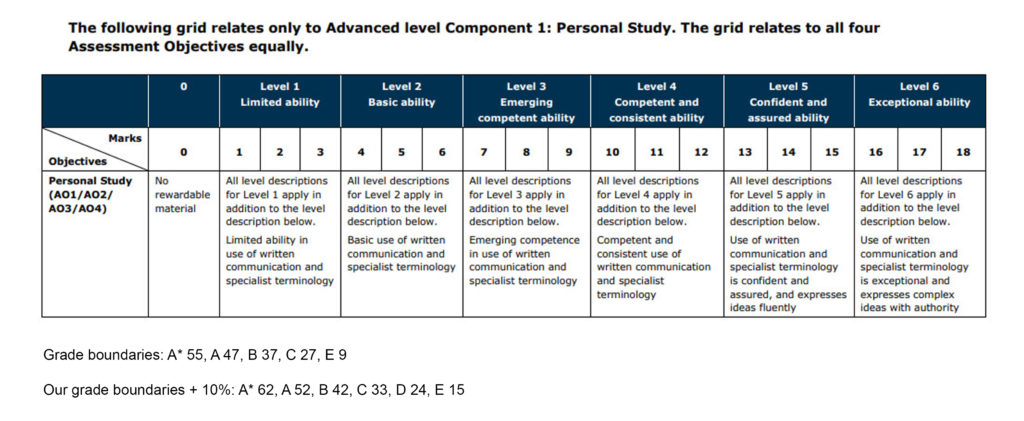
Lesson Task WED-FRI: Reviewing and reflecting
Objective: Criteria from the Syllabus
- Essential that students build on their prior knowledge and experience developed during the course.
- Develop your written dissertation in the light of your chosen focus from the practical part of previous coursework and projects.
From your Personal Investigation based on IDENTITY & COMMUNITY write an overview of what you learned so far (both as Yr 12 and Yr 13 student) and how you intend to develop your Personal Study.
1. Describe which themes, medium (photography, film), approaches (documentary, tableaux, conceptual), artists (incl contextual references to art history, movements and isms) and photographic skills, processes, techniques and methods (incl learning new software) inspired you the most and why.
2. Include examples of both previous and current experiments and imagery to illustrate your thinking.
3. Produce a new mind-map and mood-board based around how you interpret one/ or both theme(s) of IDENTITY & COMMUNITY using new artists inspirations and visual references etc. Reflect on the Island Identity project and also consider themes more broadly (see below)
4. Write a Statement of Intent that clearly contextualise;
What you want to explore?
Why it matters to you?
How you wish to develop your project?
When and where you intend to begin your study?
Make sure you describe your chosen theme (IDENTITY & COMMUNITY), subject-matter (topic, issue), artists (inspirations, references) and final outcome (photobook, film).
5. Plan your first photo-shoot as a response to initial ideas. Must be published on the blog by Wed 2 Dec.
STARTING POINTS > DEFINITIONS > INTERPRETATIONS > INSPIRATIONS
IDENTITY
plural noun: identities
- the fact of being who or what a person or thing is.”he knows the identity of the bombers”
- the characteristics determining who or what a person or thing is.”he wanted to develop a more distinctive Scottish Tory identity”
- (of an object) serving to establish who the holder, owner, or wearer is by bearing their name and often other details such as a signature or photograph.
- close similarity or affinity. “an identity between the company’s own interests and those of the local community”
What makes a person’s identity?
Identity is simply defined as the characteristics determining who or what a person or thing is. Elements or characteristics of identity would include race, ethnicity, gender, age, sexual orientation, physical attributes, personality, political affiliations, religious beliefs, professional identities, and so on.
What does the word “identity” mean to you?
Identity is about positive traits; it also can be negative traits. It’s a combination of things that you do; it’s your talents, it’s your strengths, it’s your passions, it’s what you love, it’s what you care about.
It may be useful for you to revisit your IDENTITY & PLACE project you did earlier in your photography studies.
IDENTITY POLITICS: Identity politics is the term used to describe an anti-authoritarian political and cultural movement that gained prominence in the USA and Europe in the mid-1980s, asking questions about identity, repression, inequality and injustice and often focusing on the experience of marginalised groups
Here are some blog posts from last year where we explored a number of universal and local issues in relation to the themes of LOVE & REBELLION, such as RACISM, COLONIALISM, CAPITALISM, IDENTITY POLITICS, GENDER, AUTHORITY, PROPAGANDA and CLIMATE CHANGE. Some of these issues may resonate with you when developing your focus for your Personal Study.
What Lies Below the Surface: See new work by London students exploring how photography can be used to represent the depth and diversity of our identities.

ABOUT THE PROJECT
Autograph’s learning and participation programme has always focused on supporting young people to think differently about the urgent social issues that affect their lives. We have a history of working with teachers and schools to share the ways in which visual representation intersects with issues of race, identity and human rights, and how students can make profound commentary on these questions using the camera and their creative minds.
In today’s uncertain climate this feels more necessary than ever. With heated debates on racial justice and the continuing impacts of the pandemic on our lives, we think it’s crucial for young people to have the space for creativity and self-expression, and to be supported in asking critical questions about the world around them.
Julian Germain: GENERATIONS celebrates families, individuals, diversity and the people of Birmingham and the West Midlands in large-scale photographic portraiture. Based on the aesthetic of the family portrait Germain will use a large format camera to work collaboratively with families of four and five generations from across the region. The photographs will capture details and provoke questions about our life and times.
The group portraits present people at different stages of life; new-borns, infants, children, teens and their parents, grandparents, great-grandparents and great great-grandparents. Fundamental questions are raised that relate to us all; life, death, time and the effects of time, where do we come from and where will we go?
Zanele Muholi is one of the most acclaimed photographers working today, and their work has been exhibited all over the world. With over 260 photographs, this exhibition presents the full breadth of their career to date. Muholi describes themself as a visual activist. From the early 2000s, they have documented and celebrated the lives of South Africa’s Black lesbian, gay, trans, queer and intersex communities.
“I picked up the camera because there were no images of us that spoke to me at the time when I needed them the most. I had to produce a positive visual narrative of my community and create a new dialogue with images”
Read a recent interview with Muholi here in British Journal of Photography and watch short film.
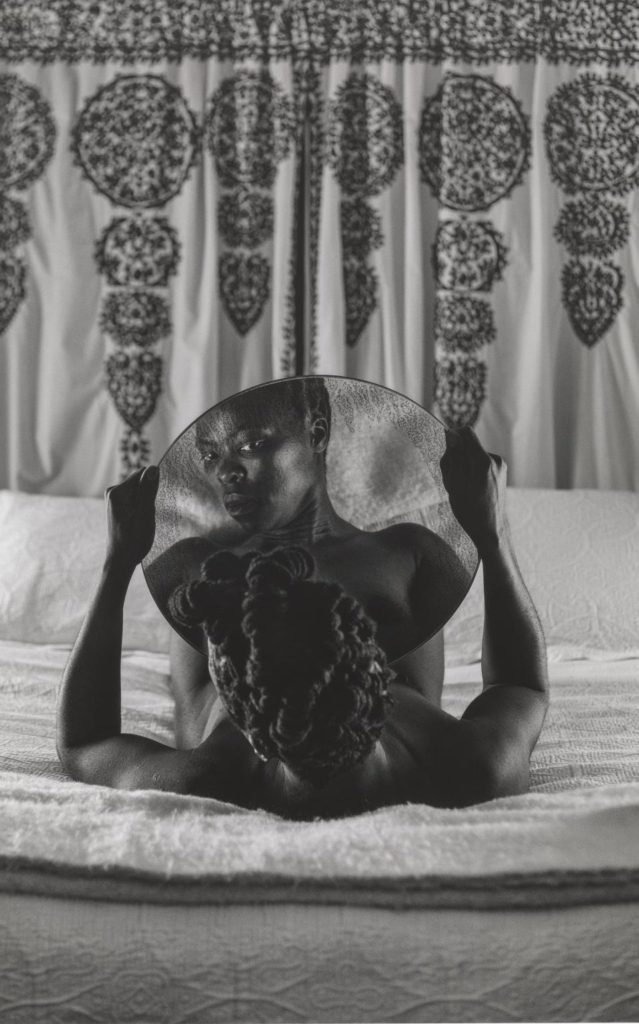
In the early series Only Half the Picture, Muholi captures moments of love and intimacy as well as intense images alluding to traumatic events – despite the equality promised by South Africa’s 1996 constitution, its LGBTQIA+ community remains a target for violence and prejudice.

In Faces and Phases each participant looks directly at the camera, challenging the viewer to hold their gaze. These images and the accompanying testimonies form a growing archive of a community of people who are risking their lives by living authentically in the face of oppression and discrimination.
Other key series of works, include Brave Beauties, which celebrates empowered non-binary people and trans women, many of whom have won Miss Gay Beauty pageants, and Being, a series of tender images of couples which challenge stereotypes and taboos.
Muholi turns the camera on themself in the ongoing series Somnyama Ngonyama – translated as ‘Hail the Dark Lioness’. These powerful and reflective images explore themes including labour, racism, Eurocentrism and sexual politics.

Nigerian multi-disciplinary artist Ken Nwadiogbu is a full time visual artist who creates innovative conceptual drawings on various surfaces as he engages in multidisciplinary modes of storytelling. Gender equality, African culture, and Black power are a few aspects of his current research and artistic practice.
CURATOR’S INTERPRETATION
“Ken Nwadiogbu believes that the advancement of reasoning which by extension is change, is mostly dependent on the ability to grasp consciousness. As such, one underlining factor of his artistry is to stimulate the viewer into being in his shoes whilst they interact with his work. He employs familiar motifs and imageries to ease them into this space.
An ideal Nwadiogbu piece constitutes a silhouette of a form, mostly human, which he embeds an eye or parts/whole of a face into— his ultimate pronouncement on the theme of creating consciousness to what represents our collective reality through art.” – Kennii Ekundayo, Art Curator Grid, 2020
ARTIST STATEMENT
We are all heroes in our movies.
My artist lens is one of a focused bystander experiencing my reality while observing the world around me. That world could be my local community, my country of Nigeria, my studio in England, or any of the living workspaces I have adopted globally. Wherever I am, I always feel the need to analyse, investigate, and perceive the news around me. As an artist, I accept the significant roles of ethnographer and strategic visionary that we artists have played in society throughout history.
My artistry reflects my own human experience and acts as a social commentary on the experience of others, so for me, that role comes with a need to be empathetic when understanding and representing the characters captured throughout various contexts in my art. My art-making process allows me to discover and reveal who we truly are at our core, whether in a moment or in a movement. One may find a reflection in the contemporary realism of my drawn faces, or in the painted expressions of fashion, or home décor – ultimately, my goal reaches beyond realism and lies in a space between authenticity and possibility.
Sammy Baloji’s artistic concern is rooted in the daily life of Congolese people, and he uses photography to explore his country’s present and to retell its history from the perspective of its people. “Ethnography, architecture, and urbanism [are] among my current focuses,” he has written. “My reading of the Congolese past is a way of analyzing African identity today, through all the political systems that the society has experienced.” He often combines archival photographs with his own shots of the people and places bearing the marks of colonialism. In his “Mémoire” series (2006), for example, he focuses on the former mining town of Lubumbashi. By superimposing photographs of the people who worked and ran the mines over his own images of these now disused structures, he reveals the ongoing ramifications of the past.


Curated by writer Ekow Eshun, and showcasing photography, prints, textile, installation and video, We Are History presents works which are moving, lyrical and thought-provoking, capturing nature as a place of both beauty and fragility. Featuring artists Alberta Whittle, Allora & Calzadilla, Carolina Caycedo, Louis Henderson, Malala Andrialavidrazana, Mazenett Quiroga, Otobong Nkanga, Zineb Sedira and a newly commissioned work by multidisciplinary artist Shiraz Bayjoo, the exhibition interrogates the environmental issues facing the southern hemisphere by looking to the past and drawing important insight from the cultural practices and knowledge systems of indigenous peoples.
Collectively, the exhibition’s contributors are looking to expand the common narrative around climate change, a subject which is often linked to the beginning of the Industrial Revolution in the West. We Are History invites visitors to look further back in time, exploring significant periods of change such as the 18th century colonial era, which saw plantation agriculture and the forced mass migration of people through slavery reshaping lives and landscapes on a global scale.
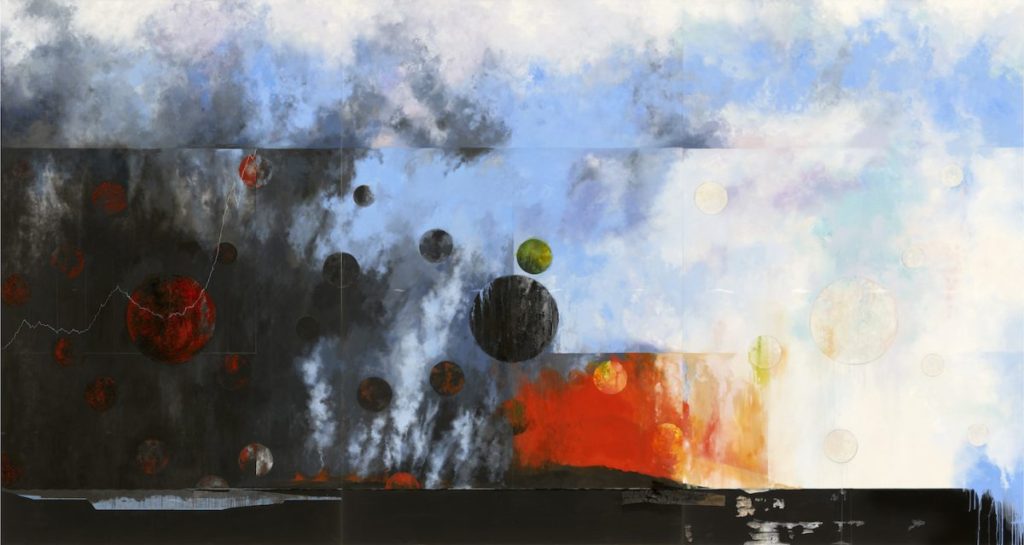
Diane Burko: Read a review Visualizing Climate Change through Abstract Expressionism of Burko new exhibition Seeing Climate Change. Her work is compared with Abstract Expressionistic painters such as Barnett Newman and Clifford Still and sublime paintings by J.M.W. Turner.
Diane Burko’s images of melting glaciers and dying coral reefs are not just pictorially impressive; they have strong emotional impact. (Carter Ratcliffe)

As a photographer how would you respond to climate change? Can a study of the environment and landscape of Jersey be an inspiration for a Personal Study?
For comparison, see work by photographers; Stephane Couturier and his series Melting Point or Urban Archaeology

Other photographers exploring ANTHROPOCENE
Edward Burtynsky (Oil, Quarries, Water, Mines, Anthropocene), Mitch Epstein (American Power), Vera Lutter (Body of Work), Michael Wolff (Architecture of Density), Philippe Chancel (Fukushima), Robert Adams (Turning Back), Edgar Martins (The Diminishing Present), Gideon Mendel (Drowning World, Scorched Surfaces), Yao Lu (New Mountain and Water), Emily Allchurch (Jersey born artist based in London)
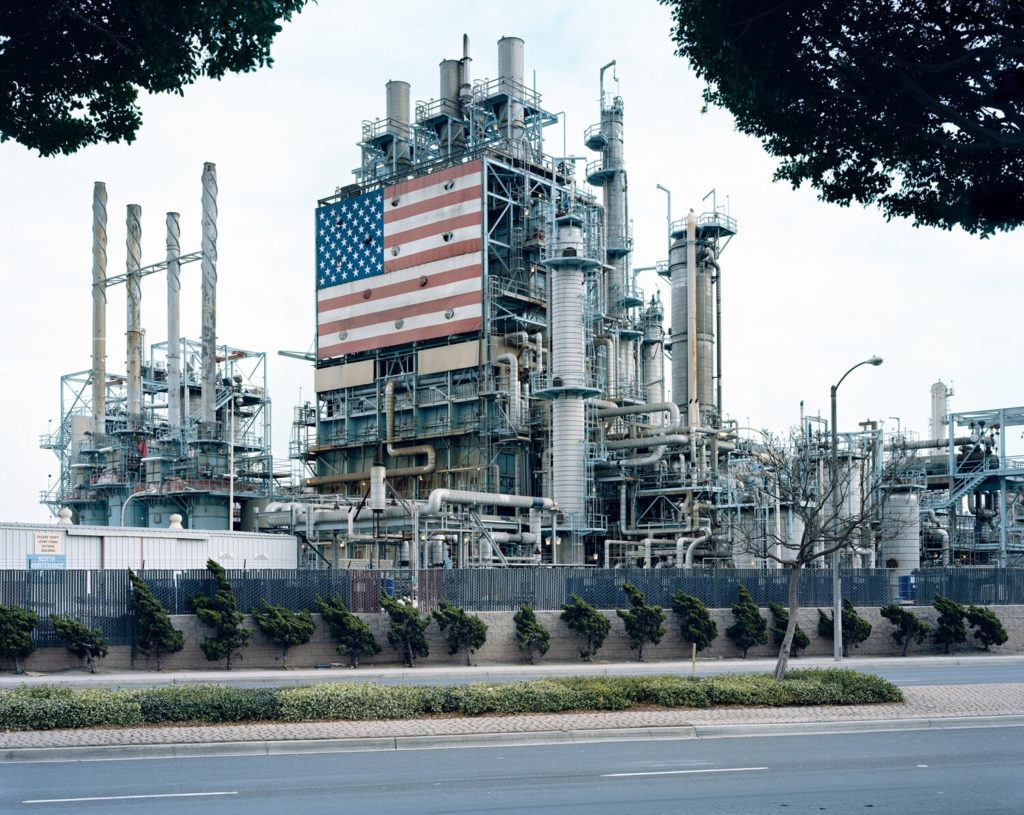
Mitch Epstein 
Edward Burtynsky 
Edgar Martins 
Emila Allchurch 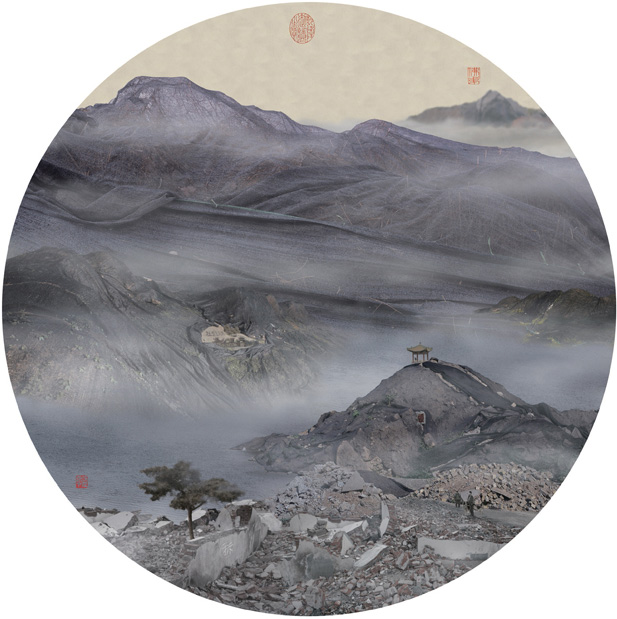
Yao Lu 
Michael Wolff 
Vera Lutter 
Phillipe Chancel 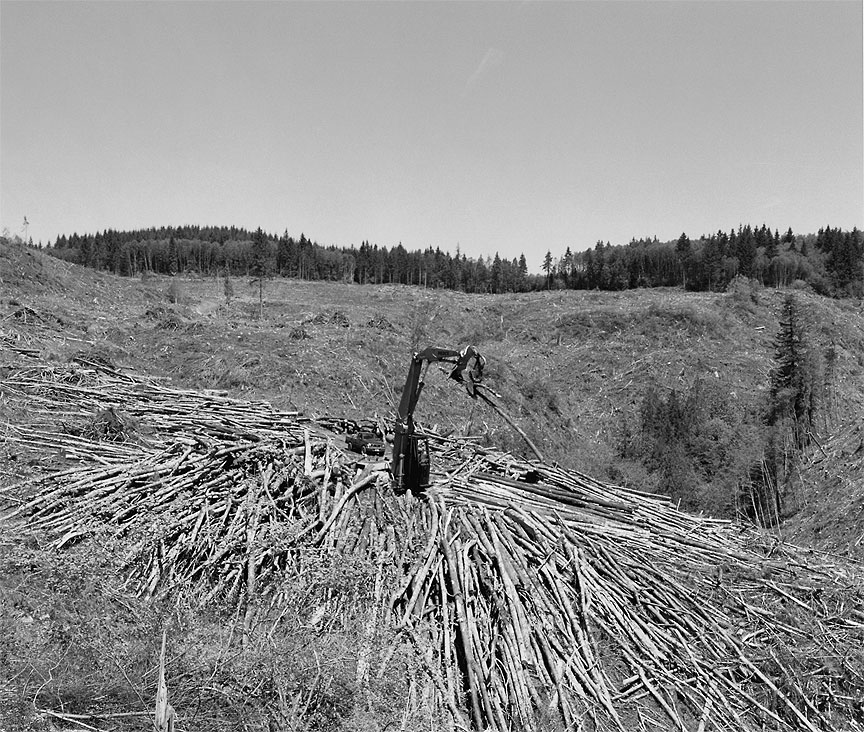
Robert Adams 
Gideon Mendel
Study latest issue: Photography+ Environment #14 from Photoworks that looks at the role of the photographer in documenting and confronting climate catastrophe. To explore this question, each writer and artist invites us to think about the relationship between photography and climate change, and between the photographer and their environment
Also go back and explore some of the ideas, artists and creative starting points from earlier in the year.

The period during which human activity has been the dominant influence on climate and the environment.
Where in Jersey is it anthropogenic?
- Open Cast Mining – Quarries: Ronez, St Peters Valley, Sand Quarry St. Ouens
- Power Stations – La Collette, Bellozane Sewage Treatment
- Urbanisation – St Helier: Grands Vaux, Le Marais Flats, Le Squez etc.
- Mass Wastage – La Collette recycling centre
- Disposable Society – La Collette recycling centre – refrigerator mountains etc
- Land Erosion – farming industry: poly tunnels, packing sheds, plastic covered fields etc. Old Glass Houses
- Over Population – poverty/social divides: Social Housing sites. Car Parks, traffic etc.
- Industrialisation – La Collette area, Bellozane, industrial estates. Desalination Plant, German Fortification (WW2)
Study latest issue: Photography+ Environment #14 from Photoworks that looks at the role of the photographer in documenting and confronting climate catastrophe. To explore this question, each writer and artist invites us to think about the relationship between photography and climate change, and between the photographer and their environment

COMMUNITY
plural noun: communities
- a group of people living in the same place or having a particular characteristic in common.”Montreal’s Italian community”
- a group of people living together and practising common ownership.noun: community; plural noun: communities“a community of nuns”
- a particular area or place considered together with its inhabitants.”a rural community”
- a body of nations or states unified by common interests.”the European Community”
- the people of a district or country considered collectively, especially in the context of social values and responsibilities; society.noun: community; noun: the community“preparing prisoners for life back in the community”
- denoting a worker or resource designed to serve the people of a particular area.modifier noun: community“community health services”
- the condition of sharing or having certain attitudes and interests in common.”the sense of community that organized religion can provide”
- a similarity or identity.”the law presupposes a community of interest between an employer and employees”
- joint ownership or liability.”the community of goods”
- ECOLOGY a group of interdependent plants or animals growing or living together in natural conditions or occupying a specified habitat. “communities of insectivorous birds”
What is difference between society and community?
The main difference between society and community is that the society is built upon interactions with varied people whereas the community is the collection of people with similar interests, essentially residing in one geographic place

COP 26: The COP26 summit will bring parties together to accelerate action towards the goals of the Paris Agreement and the UN Framework Convention on Climate Change.
Jersey Climate Conversation: Jersey’s Climate Conversation is your chance to influence change. By joining together, Jersey has the chance to do something different, to show the world what can be achieved with people power, and to create an ambitious low-carbon vision for our island.
Many other places have called citizens’ assemblies, to ask a randomly selected group of individuals to share their thoughts. But nowhere else has done this while also opening the door to the whole community to share their thoughts and ideas. We want you to share your thoughts, your visions, your ideas however big or small they are. We want you to be ambitious, bold and brave because if you are we all will be.
The ideas shared will help the Government develop the Carbon Neutral Roadmap, our long-term climate action plan for becoming carbon neutral.

Government of Jersey: Climate Emergency In response to the climate emergency the States Assembly voted to approve the Carbon Neutral Strategy. The Council of Ministers has published its Preferred Strategy for tackling the climate emergency. The detailed plans will be released for consultation in the Carbon Neutral Roadmap in December 2021.
Other Stakeholders in Jersey who promotes a greener and sustainable future includes. National Trust for Jersey, Jersey Heritage and Societe Jersiaise where you visited the Photographic Archive – it may be useful for you to research ‘old’ photos of Jersey on their online catalogue.

Sustainable Finance: Jersey Finance has launched a long-term strategic plan to support Jersey’s finance industry in its transition to a more sustainable future. Watch a series of video here from industry insiders.

Jersey Overseas Aid: Jersey Overseas Aid’s annual budget is currently 0.25% of Jersey’s GVA, totalling £12.43 million in 2020. The budget is granted by the States of Jersey from tax payer monies, for the purpose of supporting international development and providing assistance during humanitarian crises. Jersey Overseas Aid exists within the responsibilities of the Chief Minister, making it the official international development donor organisation of the States of Jersey.
Jersey Overseas Aid is governed by three States Commissioners and three non-States Commissioners, all of whom are appointed by the States of Jersey. Its day-to-day operations are managed by professional staff experienced in running development and emergency projects around the world.

Sustainable Development Goals: The 2030 Agenda for Sustainable Development, adopted by all United Nations Member States in 2015, provides a shared blueprint for peace and prosperity for people and the planet, now and into the future. At its heart are the 17 Sustainable Development Goals (SDGs), which are an urgent call for action by all countries – developed and developing – in a global partnership. They recognize that ending poverty and other deprivations must go hand-in-hand with strategies that improve health and education, reduce inequality, and spur economic growth – all while tackling climate change and working to preserve our oceans and forests.

EXHIBITION: Research and explore IN PROGRESS: Laia Abril – Hoda Afshar – Widline Cadet – Adama Jalloh – Alba Zari at the RPS Gallery (20 May – 31 October 2021) commissioned by the RPS as part of Bristol Photo Festival. Click on link image below.

CONSIDER COMMUNITY: Imagine you were the official photographer of your street, neighbourhood, town or city. You have been commissioned to create a sequence of photographs celebrating the spirit of this place and its people. These images will be published in various forms – in a free newspaper, on posters in bus shelters, on postcards , on advertising hoardings etc. You are limited to 10 pictures in total. Make a larger body of images, then edit these down to just 10. Arrange in a sequence or collage. What story do they tell? What are the challenges of an activity such as this and how might you set out to overcome these?
There are different approaches to how photographers work with a community. Either as a outsider looking in or as an insider who is part of that community. The best work often emerges from photographers who work with a social group that they are familiar with or have a personal connection to. A community can be defined as a group of people who share the same values, cultural codes and perform certain social rituals. This group could be family and friends or an estate or a neighbourhood. It could be a recreational activity or a sport.
Week 13: 29 Nov – 5 Dec
Theory & Practice: Artists References
Contextual Studies: Conversations on Photography
STATEMENT OF INTENT
Write a Statement of Intent that clearly contextualise;
What you want to explore?
Why it matters to you?
How you wish to develop your project?
When and where you intend to begin your study?
Make sure you describe your chosen theme (IDENTITY & COMMUNITY), subject-matter (topic, issue), artists (inspirations, references) and final outcome (photobook, film).
Plan your first photo-shoot as a response to initial ideas. Must be published on the blog by Wed 8 Dec.
THEORY > ANALYSIS
Objective: Criteria from the Syllabus
- Select artists work, methods, theories and art movements appropriate to your previous coursework work as a suitable basis for your Personal Study.
- Investigate a wide range of work and sources
ARTISTS REFERENCES: Select 2-3 artists/photographers that have inspired your work already and that you would like to research in depth as a basis for your Personal Study. Compare and contrast their practice and work following these steps:
- Produce a mood board with a selection of images and write an overview of their work, methods, style, approach and subject matter.
- Select at least one image from each photographer and analyse in depth using methodology of TECHNICAL > VISUAL > CONTEXTUAL > CONCEPTUAL.
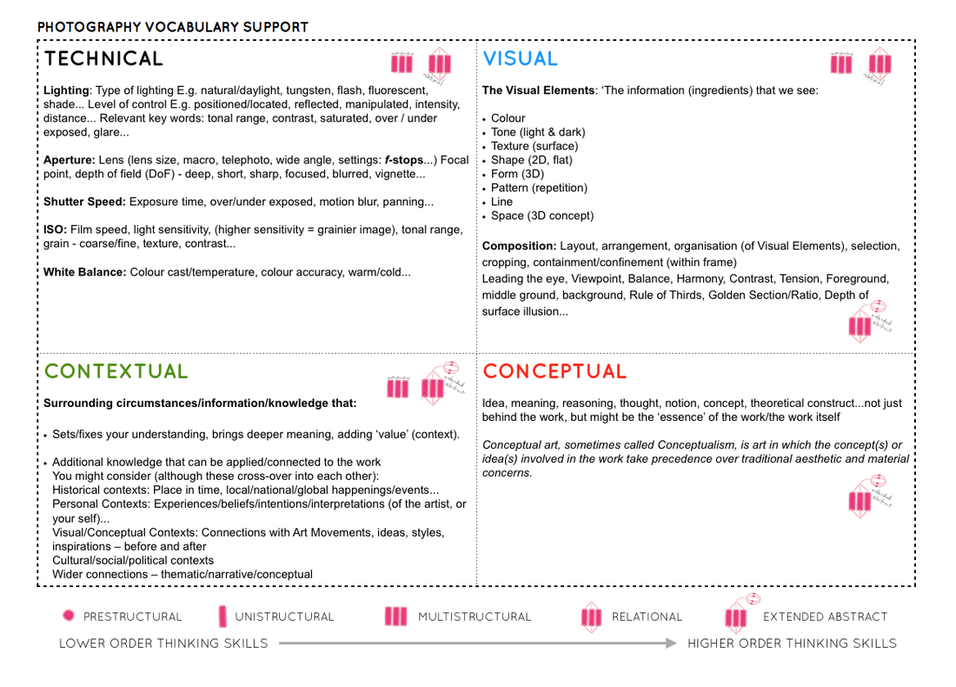
MEANING & METHODS: Identify meaning and methods behind selected artists/photographers work and research at least 3 different literary sources (online articles, books, Youtube clips) that will provide you with different critical perspective and views other than your own.
The literary sources will also provide you with something to read for further contextual understanding and critical thinking in preparation for writing your essay. Make sure you save hyperlinks photocopies etc in a new folder: Academic References.
- Incorporate quotes and comments from artist themselves or others (art critics, art historians, curators, writers, journalists etc) using a variety of sources such as Youtube, online articles, reviews, books
- Make sure you reference sources and embed links to the above sources in your blog post.
WED 1 Dec: CONTEXTUAL STUDIES 1
Conversations on Photography: As a case study read one interview, identity 3 quotes and apply theory to a analysis of one image.
Go to Blogpost here for more details
PRACTICE > RESPONSES
PLANNING: Plan a shoot in response to researching and interpreting artists work above. Make sure it relates to your ideas on how you intend to develop your project. Follow these instructions: what, why, how, when, where?
RECORDING: Complete planned photo-shoot and bring images in to class. Begin to edit and show experimentation with images using Lightroom / Photoshops/ Premiere as appropriate to your intentions. Make sure you annotate processes and techniques used.
EVALUATION: Upon completion of photoshoot and experimentation, make sure you evaluate and reflect on your next step of development. Comment on the following:
- How successful was your photoshoot and experimentation?
- What references did you make to artists references? – comment on technical, visual, contextual, conceptual?
- How are you going to develop your project from here? – comment on research, planning, recording, experimenting.
- What are you going to do next? – what, why, how, when, where?
PHOTOGRAPHERS / ARTISTS
You can find other alternative inspirations and artists references here:
Raymond Meeks (Halfstory, Halflife), Theo Gosselin (Sans Limites), Jen Davis (Eleven Years), Diana Markosian (Inventing my Father, Santa Barbara), Doug Dubois (My Last Day at Seventeen), Alessandra Sanguinetti (The Illusion of an everlasting Summer), Justine Kurland (Girl Picture), Jim Goldberg (Raised by Wolves) Sophie Calle (Suite Vénitienne), Nick Waplington (Living Room), Nan Goldin (The Ballad of Sexual Dependency), Corinne Day, (Dairy), Martin Parr (Signs of the Time, Common Sense, The Cost of Living), Chris Killip (Isle of Man: A book about the Manx), Lauren Greenfield (Fast Forward, Girl Culture), Nicholas Nixon (the Brown Sisters), Robert Clayton (Estate), Valerio Spada (Gomorrah Girl), Martin Gregg (Midlands), Alain Laboile, (At the Edge of the World, Sian Davey (Looking for Alice, Martha), Laia Abril (The Epilogue), Rita Puig-Serra Costa (Where Mimosa Bloom), Carole Benitah, (Photo Souvenirs), Richard Billingham (Ray’s a Laugh), Larry Sultan (Pictures from Home), Matt Eich: I Love You, I’m leaving, Yoshikatsu Fujii: Red Strings, Junpei Ueda: Pictures of My life, Sam Harris (The Middle of Somewhere), Dana Lixenberg (Imperial Courts), Philip Toledano (Days with my Father, When I was Six), Mariela Sancari (Moises is not Dead), Yury Toroptsov (Deleted Scene, The House of Baba Yaga), Amak Mahmoodian (Shenasnameh), Colin Pantall, (All Quite on the Homefront), Mitch Epstein (Family Business), Jason Wilde (Vear & John, Silly Arse Broke It), LaToya Ruby Frazier (The Notion of Family),

Doug DuBois: My Last Days of Seventeen
The title, “My last day at Seventeen,” was first uttered by Eirn while I was taking her photograph in her parents’ back garden on the eve of her 18th birthday. Although Eirn argues her remark was more properly phrased, “ it’s my last day as seventeen” the sentiment is the same: there is a time in everyone’s life where the freedom and promise of childhood are lost to the coming of age and experience. The process can be gradual or abrupt; it can begin at age 18, 12 or 40.
The photographs were made over a five year period in the town of Cobh, County Cork in Ireland. I came to Cobh at the invitation of the Sirius Arts Centre in the summer of 2009. Ireland had just begun its sharp decline from the boom years of the Celtic Tiger. I spent my days trying to ingratiate myself with contractors to gain access to building sites that lay abandoned throughout the Irish countryside. I got nowhere.

Raymond Meeks: Every summer, since as long as anyone in the area can remember, groups of teenage boys and girls have been congregating by a single-lane bridge that spans the tributaries of Bowery and Catskill Creeks in the Catskill Mountain region of New York. Just below it, in the wilderness, a waterfall drops sixty feet above a pond. Those daring enough to take the leap usually take a small run-up before flinging themselves off the precipice. Within the act of the jump and its timeless ritual lingers the last fleeting moments of youth, of endless summer days and reckless abandon. Beyond that, the unknown.
Known for his slow-burning chronicles of rural America, Raymond Meeks turns his attention to Furlong and its intrepid summer dwellers in his most recent book Halfstory Halflife. Sketching out his local area with a sensitive lyricism, Meeks observed its energy and atmosphere over the course of three years; the spectacle of the wait, the anticipation of the climb and the final leap into darkness, where time comes to a standstill as bodies are frozen in motion. These everyday experiences and rituals, simple and carefree in their nature, gain a weight and significance through the lens, as the bodies fall somewhere beyond the threshold of youth and into adulthood.
Theo Gosselin ( Sans Limites): The much anticipated follow up to his highly successful debut book Avec Le Coeur, Sans Limites by Théo Gosselin presents a glimpse of a life beyond boundaries – unrestricted by limitations of geography and social conventions. The result of the photographer´s most recent road trips across the US, Spain, Scotland and native France,
At times, Gosselin´s work approaches something akin to poésie bucolique; his photographs representing modern day pastoral landscapes that resemble 21st century equivalents of Poussin’s Et in Arcadia ego, Manet’s Déjeuner sur L’herbe or Cézanne’s Les Grandes Baigneuses. At other times, his images capture moments more resonant of Bacchanalian scenes. Deliberately cinematic, Gosselin’s photography reveals friends in the act of escaping from their regular lives into newly enticing and perilous modes of existence, ever in search of the persistent though elusive idea of freedom.

Jim Goldberg: Raised By Wolves. The personal story behind the making and the legacy of Goldberg’s seminal work about marginalized youth, which occupies the liminal space between documentary and narrative fiction
Jen Davis has spent eleven years working on a series of self-portrait ’s dealing with issues regarding beauty, identity, and body image. Her poignant and beautifully articulated photographs have recently been published Kehrer Verlag in a monograph titled, Eleven Years.For over a decade Jen has bravely turned the camera on herself revealing a journey of self analysis and self awareness that while very personal, it incredibly universal. Her work reflected a mastery of light and color.
Haley Morris-Cafiero: Wait Watchers
For my series, Wait Watchers, I set up a camera in a public area and photograph the scene as I perform mundane tasks while strangers pass by me. I then examine the images to see if any of the passersby had a critical or questioning element in their face
or body language. I consider my photographs a social experiment and I reverse the gaze back on to the stranger and place the viewer in the position of being a witness to a moment in time. The project is a performative form of street photography.
I place the camera on a tripod and take hundreds of photographs. The resulting images capture the gazer in a microsecond moment where the shutter, the scene, my actions and their body language align and are frozen on the frame. I do not know what the
people in my photographs are looking at or reacting to. I present the images to the world to start a conversation about the gaze and how we use it communicate our thoughts of others.
Diana Markosian: Inventing my Father
For most of my life, my father was nothing more than a cut out in our family album.
An empty hole.
A reminder of what wasn’t there.
I have few childhood memories of him.
In one, we are dancing together in our tiny apartment in Moscow. In another, he is leaving.
My father would disappear for months at a time. Then, unexpectedly, he would come home.
Until, one day, it was our turn to leave.
The year was 1996.
My mother woke me up and told me to pack my belongings. She said we were going on a trip, and the next morning we arrived in our new home, in California.
We never said goodbye to my father.
For my mom, the solution to forget him was simple. She cut his image out of every photograph. But those holes made it harder for me to forget him.
I often wondered what it would have been like to have a father.
I still do.

Diana Markosian Santa Barbara
When I was seven years old, living with my family in Moscow, my mother woke me up in the middle of the night and said we were going on a trip. The year was 1996. The Soviet Union had long collapsed, and by then, so had my family. We left without saying goodbye to my father, and the next day landed in a new world: America.
Inspired by the 1980s American soap opera Santa Barbara, my mother enrolled with an agency in Russia that posted listings in American newspapers and catalogs for so-called mail-order brides. She was 35. We arrived to the coastal town of Santa Barbara, and were met by an older man who would soon become her husband, and take the place of my own father. And this is where the story begins. The idea of touching something that felt untouchable.
Yury Toroptsov: Deleted Scene
I returned to Russia to visit the scattered remnants of my father’s memory. In fact, I hardly know anything about him. He died before I turned two. I have no personal memories of him. Almost nothing that could have recalled its existence has survived. There was just his camera. When I was nine, I found it in the closet where my mother had kept it safe for years. I took it apart to the last screw as if I was looking for something hidden inside. With my own unconscious hands, I destroyed the last object that bound us to my father.
There are still his photos, which he had taken and drawn himself. My father was an amateur photographer. In one of these photos, I am a five month old baby lying face down on my parents’ bed. My eyes are fixed on him, the photographer. My father, who has only thirteen months to live.
His untimely death made him an abstract character, a shadow at the gates of nothingness. He was almost forgotten. No one spoke of him anymore. His grave has been abandoned. All I knew about him was from a few stories that people who knew him told me. Despite everything, these stories told and repeated with more or less precision depending on the witness maintained a semblance of memory. Just as folklore is passed on, repeated and revised from generation to generation.
LaToya Ruby Frazier (The Notion of Family); In this, her first book, LaToya Ruby Frazier (born 1982) offers an incisive exploration of the legacy of racism and economic decline in America’s small towns, as embodied by Braddock, Pennsylvania, Frazier’s hometown. The work also considers the impact of that decline on the community and on her family, creating a statement both personal and truly political

Sophie Calle’s practice is characterised by performances using rule-based scenarios, which she then documents. Venetian Suite consists of black and white photographs, texts and maps that document a journey the artist made to Venice in order to follow a man, referred to only as Henri B., whom she had previously briefly met in Paris. Although Calle undertook the journey in 1979, the texts describe the actions as taking place in 1980. Venetian Suite records Calle’s attempts to track her subject over the course of his thirteen-day stay in Venice. She investigates and stalks him, enlisting the help of friends and acquaintances she makes in the city. Eventually Henri B. recognises Calle, and they share a silent walk. Even after this encounter Calle continues her project, shadowing Henri B. from a distance until his arrival back in Paris. The work was initially produced in book form in 1983; the same year Calle also presented the work as a sound installation in a confessional booth. In 1996 she configured Venetian Suite as a gallery-based work, the appearance of which deliberately recalls a detective casebook, with texts written in a style that mimics and deconstructs the narrative tension typical of detective novels or film noir. The text begins as follows:
For months I followed strangers on the street. For the pleasure of following them, not because they particularly interested me. I photographed them without their knowledge, took note of their movements, then finally lost sight of them and forgot them. At the end of January 1980, on the streets of Paris, I followed a man whom I lost sight of a few minutes later in the crowd. That very evening, quite by chance, he was introduced to me at an opening. During the course of our conversation, he told me he was planning an imminent trip to Venice. I decided to follow him.
(Calle and Baudrillard 1988, p.2.)

Matt Eich: I Love You, I’m leaving
Love You, I’m Leaving is my meditation on familial bonds, longing, and memory. The series borrows from personal experience and the visual language of the everyday in order to create a fictional account that mirrors my reality. Made during a time of personal domestic unease, I photographed as my parents separated, and my family moved to a new city.

Yoshikatsu Fujii: Red Strings
I received a text message. “Today, our divorce was finalized.” The message from my mother was written simply, even though she usually sends me messages with many pictures and symbols.
I remember that I didn’t feel any particular emotion, except that the time had come. Because my parents continued to live apart in the same house for a long time, their relationship gently came to an end over the years. It was no wonder that a draft blowing between the two could completely break the family at any time.
In Japan, legend has it that a man and woman who are predestined to meet have been tied at the little finger by an invisible red string since the time they were born. Unfortunately, the red string tying my parents undone, broke, or perhaps was never even tied to begin with. But if the two had never met, I would never have been born into this world. If anything, you might say that there is an unbreakable red string of fate between parent and child.
If you are interested in exploring the themes of LOVE & REBELLION within the notion of family have a look at different approaches within documentary and tableaux photography here
Family can be interpreted in different ways, one is to consider it in relation to the concept of HOME – which can be interpreted as both family or community. Home is also more than just the four walls of your house where you live with your family. Jersey, the island where you perhaps are born or where you grew up can be considered a home too. Home can be interpreted as a community. If you are away from home you often think about your home with a sense of nostalgia. Home can be associated with memories, feelings, hopes, fears etc.
Or Laura El-Tantawy and her project the uprising and protests in her homeland of Egypt , In The Shadow of Pyramids
GUERNSEY PHOTOGRAPHY FESTIVAL (GPF): The theme for 2021 will be Acts of Love and Rebellion. Below is a list of photographers who will be exhibiting at the next festival with work relating to the two themes of LOVE and REBELLION. If we manage to produce a newspaper it will be exhibited at the festival in Guernsey in Sept 23 – 24 Oct 2021.
Alec Soth (Looking for Love), (Niagara), (I Know How Furiously Your Heart Is Beating), Gideon Mendel (Freedom or Death), Elisa Larvego (Chicanes), Fergus Greer (Leigh Bowery), David Fathi (The dead govern the living) Anna Lim (Rehearsal of anxiety), Karl Ohiri (How to mend a broken heart), Ulrich Leboeuf (Khaos Agence Myop), Zoe Aubry (Impact en quête de révolution), Samuel Fordham (C-R92/BY Skype Families), Hannah Modigh (Hurricane Season), Chloe Jafé (I give my life to you), Tara Fallaux (The Perfect Pearl), Sylvain Granjon (Rebels).

David Fathi, THE DEAD GOVERN THE LIVING
Site-specific installation
FILMMAKERS / CINEMA
Have a look at the many references to video art, avantgarde cinema and experimental filmmaking listed in these blogposts below
Week 14: 6 – 12 Dec
Theory & Practice:: The Origins of Photography
The syllabus states clearly that you have to be aware of some of the methods employed by critics and historians within the history of art and photography.
To demonstrate your knowledge and understanding you will have to write a paragraph in your essay providing historical context about your chosen artists/ photographers and how their work and practice is linked to a specific period of photographic history, art movement/ ism or theory.
In preparation of this you are required in the remaining two weeks (before Christmas) to produce two pieces of writing between 500-1000 words each. In addition you are required to plan and produce a photographic response or experiment.
1. HISTORY > The Origins of Photography
500-1000 words
Your first task is to learn about the origins of photography. Click on this link below and follow instructions.
2. PRACTICE > Photographic responses
- Make a creative response to some of the early photographic processes that you have written about above. Be creative and explore both in camera techniques and digital mastering using Photoshop/ Lightroom. If possible, make it relevant to your own project.
- Produce a blog post and publish by – Wed 15 Dec
Week 14 + XMAS: 13 Dec – 5 Jan
Theory & Practice: Art Movements & Isms
2. THEORY > Art Movements & Isms
500-1000 words
For this task you need to select an art movement and ism that is relevant to your Personal Study and make a 2-3 minutes presentation in class. You can choose to work alone or pair up with a fellow student:
- Pictorialism
- Realism / Straight Photography
- Modernism
- Post-modernism
Follow these instructions:
Start by watching the films below, study PPT presentations and read articles here which will provide you with an overview.
M:\Departments\Photography\Students\LOVE & REBELLION\Presentations
How Did Pictorialism Shape Photography and Photographers ?
Realism vs Pictorialism: A Civil War in Photography History
Movements: Straight Photography
- Write 500 words which would form the basis of paragraph 1 in your essay on Historical/ theoretical context and publish on blog.
- Use information you gathered in Art Movements & Isms sheet as a starting point for your paragraphs
- Select two literary sources from above and identify relevant quotes (at least two) that you can incorporate into your paragraph.
- Your paragraph must include visual examples of artists making work within that art movement that is relevant to your Personal Study.
- Prepare a 2-3 mins presentation at the end of the week Fri 17 Dec
PRACTICAL WORK
PLANNING: Produce a detailed plan of at least 3-4 photoshoots that you intend on doing in the next 3-4 weeks
– including Christmas break. Follow these instructions: what, why, how, when, where?
XMAS BREAK
RECORDING: Produce a number of photographic response to your Personal Study and bring images from new photo-shoots to lessons:
READING: Key texts (interviews, reviews, articles etc.) about your subject, photo-history and chosen artists in preparation of writing your essay in January.
Week 15: 5 – 10 Jan
Practical work: Define Story & Narrative
Planning & Storyboarding
Objective: Criteria from the Syllabus
- Show evidence for an on-going critical and analytical review of your investigation – both your written essay and own practical work in response to research and analysis.
PHOTOBOOK
PLANNING
STORY: What is your story?
Describe in:
- 3 words
- A sentence
- A paragraph
NARRATIVE: How will you tell your story?
- Images > new photographic responses, photo-shoots
- Archives > old photos from family albums, iPhone
- Texts > letters, documents, poems, text messages
PRACTICAL WORK
PLANNING: Produce a detailed plan of at least 3-4 photoshoots that you intend on doing in the next 3-4 weeks
– including Christmas break. Follow these instructions: what, why, how, when, where?
RECORDING: Produce a number of photographic response to your Personal Study and bring images from new photo-shoots to lessons:
• Save shoots in folder on Media Drive: and import into Lightroom
• Organisation: Create a new Collection from each new shoot inside Collection Set: IDENTITY & COMMUNITY
• Editing: select 8-12 images from each shoot.
• Experimenting: Adjust images in Develop, both as Colour and B&W images appropriate to your intentions
• Export images as JPGS (1000 pixels) and save in a folder: BLOG
• Create a Blogpost with edited images and an evaluation; explaining what you focused on in each shoot and how you intend to develop your next shoot.
• Make references to artists references, previous shoots, experiments etc.
EXPERIMENTING:
• Export same set of images from Lightroom as JPEG (4000 pixels) • Experimentation: demonstrate further creativity using Photoshop to make composite/ montage/ typology/ grids/ diptych/triptych, text/ typology etc appropriate to your intentions • Design: Begin to explore different layout options using InDesign and make a new zine/book. Set up new document as A5 page sizes. This is trying out ideas before we begin designing photobook in January.
• Make sure you annotate process and techniques used
EVALUATION: Upon completion of photoshoot and experimentation, make sure you evaluate and reflect on your next step of development. Comment on the following:
- How successful was your photoshoot and experimentation?
- What references did you make to artists references? – comment on technical, visual, contextual, conceptual?
- How are you going to develop your project from here? – comment on research, planning, recording, experimenting.
- What are you going to do next? – what, why, how, when, where?
FILM
PLANNING
STORY: What is your story?
Describe in:
- 3 words
- A sentence
- A paragraph
NARRATIVE: How will you tell your story?
- Visuals > new photographic responses, photo-shoots
- Sound > ambient, sound fx, voice-over, interview, music
- Archives > found imagery, footage, audio
PRACTICAL WORK
STORYBOARDING: Based on your specification and narrative produce a storyboard with details of individual scenes, action, shot sizes, camera angles and mise-en-scene (the arrangement of the scenery in front of the camera) from location, props, people, lighting, sound etc.
PLANNING: Produce a detailed plan of at least 3-4 video/audio recordings that you intend on doing in the next 3-4 weeks
– incl Christmas break
RECORDING: Produce a number of photographic response to your Personal Study and bring footage from video/ audio recordings to lessons:
• Save media in folder on local V:Data Drive
• Organisation: Create a new project in Premiere
• Editing: begin editing video/ audio clips on the timeline
• Adjusting: recordings in Colour / B&W appropriate to your intentions.
EXPERIMENTING:
• Video: experimenting with sequencing using relevant transitions and effects
• Sound: consider how audio can add depth to your film, such as ambient sound, sound fx, voice-over, interview, musical score etc. • Title and credits: Consider typography/ graphics/ styles etc. For more creative possibilities make title page in Photoshop (format: 1280 x 720 pixels) and import as a Psd file into your project folder on the V-Data drive.
EVALUATING: Write an evaluation on the blog that reflects on your artistic intentions, film-editing process and collaboration. Include screen-prints from Premiere and a few ‘behind the scenes’ images of the shooting/ production for further annotation. Comment on the following:
- How successful was your photoshoot and experimentation?
- What references did you make to artists references? – comment on technical, visual, contextual, conceptual?
- How are you going to develop your project from here? – comment on research, planning, recording, experimenting.
- What are you going to do next? – what, why, how, when, where?
MON: Academic Sources
Week 16: 10 – 16 Jan
Essay writing: Academic study skills
Contextual Study: Decoding Photography
- Research and identify 3-5 literary sources from a variety of media such as books, journal/magazines, internet, Youtube/video that relates to your personal study and artists references .
- Begin to read essay, texts and interviews with your chosen artists as well as commentary from critics, historians and others.
- It’s important that you show evidence of reading and draw upon different pints of view – not only your own.
- Take notes when you’re reading…key words, concepts, passages
- Write down page number, author, year, title, publisher, place of publication so you can list source in a bibliography
Bibliography
List all the sources that you have identified above as literary sources. Where there are two or more works by one author in the same year distinguish them as 1988a, 1988b etc. Arrange literature in alphabetical order by author, or where no author is named, by the name of the museum or other organisation which produced the text. Apart from listing literature you must also list all other sources in alphabetical order e.g. websites/online sources, Youtube/ DVD/TV.
Quotation and Referencing:
- Use quotes to support or disprove your argument
- Use quotes to show evidence of reading
- Use Harvard System of Referencing…see Powerpoint: harvard system of referencing for further details on how to use it.
TUE: Essay Question
- Think of a hypothesis and list possible essay questions
- Here is a list of possible questions to investigate that may help you.
WED 12 JAN: CONTEXTUAL STUDIES 2
Decoding Photography
• Select one of the questions listed
• Read text in detail, make notes and identify 3 quotes
• Select one image from examples mentioned in text and apply your own interpretation of the photograph by applying theory and critical thinking
• Incorporate the 3 quotes above into your interpretation of the image and make sure you comment on the quotes.
Go to Blogpost here for more details
THUR: Essay Plan
Make a plan that lists what you are going to write about in each paragraph – essay structure
- Essay question:
- Opening quote
- Introduction (250-500 words): What is your area study? Which artists will you be analysing and why? How will you be responding to their work and essay question?
- Pg 1 (500 words): Historical/ theoretical context within art, photography and visual culture relevant to your area of study. Make links to art movements/ isms and some of the methods employed by critics and historian. Link to powerpoints and resources above about art movements and isms.
- Pg 2 (500 words): Analyse first artist/photographer in relation to your essay question. Present and evaluate your own images and responses.
- Pg 3 (500 words): Analyse second artist/photographer in relation to your essay question. Present and evaluate your own images and responses.
- Conclusion (250-500 words): Draw parallels, explore differences/ similarities between artists/photographers and that of your own work that you have produced
- Bibliography: List all relevant sources used
FRI: Essay Introduction
In this lesson you will write a 45 mins draft essay introduction following these steps:
- Open a new Word document > SAVE AS: Essay draft
- Copy essay question into Essay title: Hypothesis > if you don’t have one yet, make one!
- Copy your essay introduction (from Essay Plan) which will give you a framework to build upon and also copy your Statement of Intent.
- Identify 2 quotes from sources identified in an earlier task using Harvard System of Referencing.
- Use one quote as an opening quote: Choose a quote from either one of your photographers or critics. It has to be something that relates to your investigation.
- Add sources to Bibliograpphy > if by now you don’t have any sources, use S. Sontag. On Photography Ch1
- Begin to write a paragraph (250-500 words) answering the following questions below.
- You got 45 mins to write and upload to the blog!
- Think about an opening that will draw your reader in e.g. you can use an opening quote that sets the scene. Or think more philosophically about the nature of photography and and feeble relationship with reality.
- You should include in your introduction an outline of your intention of your study e.g.
- What are you going to investigate.
- How does this area/ work interest you?
- What are you trying to prove/challenge, argument/ counter-argument?
- Whose work (artists/photographers) are you analysing and why?
- What historical or theoretical context is the work situated within. Include 1 or 2 quotes for or against.
- What links are there with your previous studies?
- What have you explored so far in your Coursework or what are you going to photograph?
- How did or will your work develop.
- What camera skills, techniques or digital processes in Photoshop have or are you going to experiment with?
Week 17: 11 – 10 Jan
PRESENTATION – Work-in-Progress
Prepare a 3-5 mins presentation on something that you are working on right now in your project. For example:
An idea
An image
A photo-shoot
An experiment
An inspiration
New research
New development
Use blog posts to present in class. As a class we will give constructive feedback on how each student can develop their work and project.
checklist: NFT Project
DEADLINE: FRI 12 NOV
FINAL OUTCOME: Each group produce a 30 sec animated film and 1 digital image following these steps:
- Develop a concept
- Make a storyboard
- Plan recording/ shoots
- Experiment with imagery, sound and text using different analogue & digital processes supported by creative workshops
- Edit a 30 sec animated movie
- Design a digital image (A2) based on your film
- Present final film and digital image
GROUPS
13B:
Chantal L-B, Elisha Hiller
Karina, Sophie, Carmen, Olivia
Cerys, Anais, Anya, Jess
Michael, Reuben, Matt, Ollie, Katey R-H
13C:
Wiki, Elisha Harvey, Niamh
Joana, Tiago, Olivia, Beth
Eleanor, Francisco, Toni
In each group you need to allocate responsibility to take on the the following roles:
Producer > project manager
Photographer > cameraman
Editor > designer
CHECKLIST
Use this simplified list to check that you are on task. Every item on the list represents one piece of work = one blog post. It is your responsibility as an A-level student to make sure that you complete and publish appropriate blog posts each week. All tasks and learning resources in the Autumn Planner above.
WEEK 1: 14-19 Sept
1. Mindmap
2. Moodboard
3. Statement of Intent
WEEK 2: 20-26 Sept
1. Contextual study 1: NFTs and digital art
2. Artists Reference 1: NFT artists
3. Recording: Shoot 1 > Plan a response
Week 3: 28 Sept – 3 Oct
1. Contextual study 2: Bayeux Tapestry or Occupation Tapestry
2. Artists Reference 2: Contemporary artist: textiles & embroidery
3. Experiment 1: Embroidery & Narrative
Week 4: 4 – 10 Oct
1. Storyboard
2. Experiment 2: Animation using After Effects
Week 5: 11 – 17 Oct
1. Recording: produce final shoots for film
2. Editing: Image & sound
Week 6: 18 – 22 Oct
1. Editing 30 sec Film
2. Produce 1 digital image (A2)
3. Progress Report
Week 7-8: 1 – 12 Nov:
1. Complete Film + title
2. Complete Digital Image + title
3. Complete Embroidery – Yulia workshop Wed 10 Nov to make one large tapestry from individual pieces
4. Evaluation
5. Statement: 100 words: EXHIBITION: 2 LIVES
Describe the concept and meaning behind your film and digital image. You can use your statement of intent as a starting point.
Zine: if you manage to complete all the above, re-visit Zine project and make sure you have completed design and packaged it up ready for printing.
Save as File > Package > file name: title of zine > create folder in your name here: M:\Departments\Photography\Students\Image Transfer\IDENTITY & COMMUNITY\ZINE
Final outcomes to have completed so far:
Zine
Embroidery
NFT film
NFT digital image

